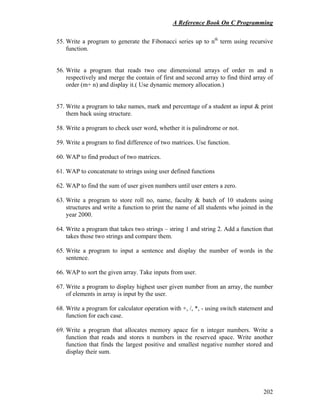This document provides a historical overview of the development of computers from ancient times to the present. It discusses the major milestones and innovations that progressed computing, including the abacus, mechanical adding machines, punched cards, vacuum tubes, transistors, integrated circuits, and microprocessors. The development is divided into five generations characterized by the components and technology used. The modern computer era began with the invention of the microprocessor, which allowed computers to become smaller, more affordable personal devices.
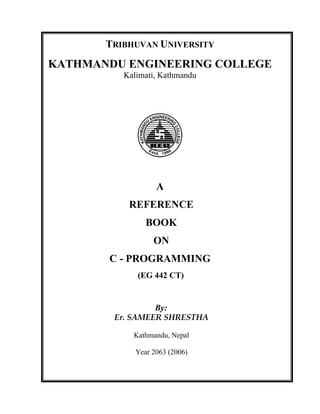











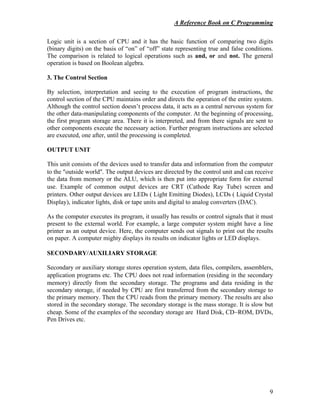


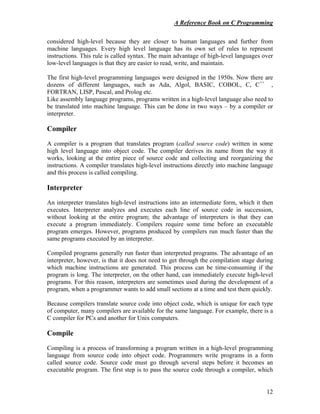





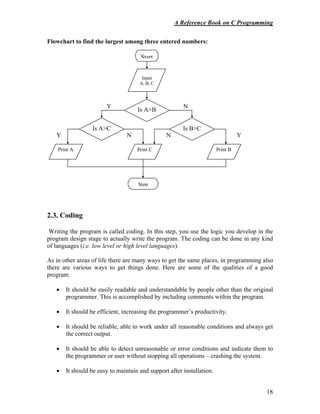





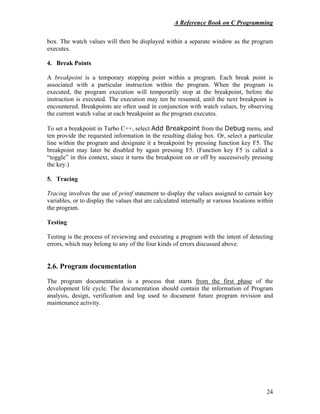


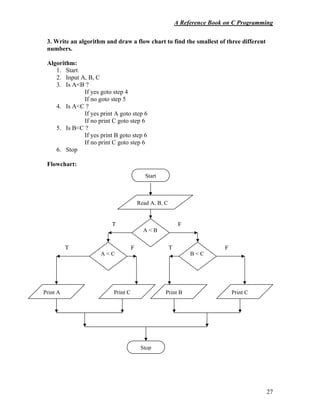





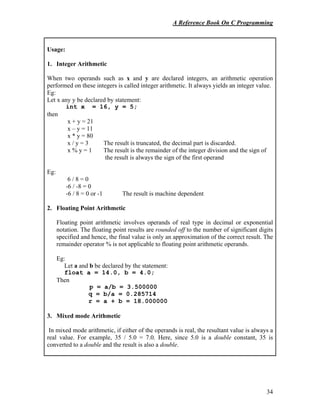






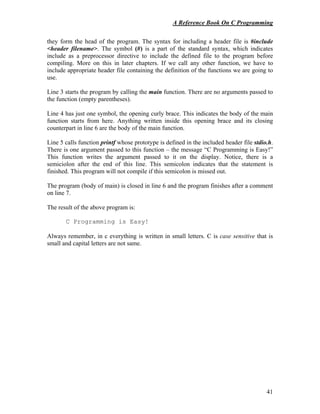

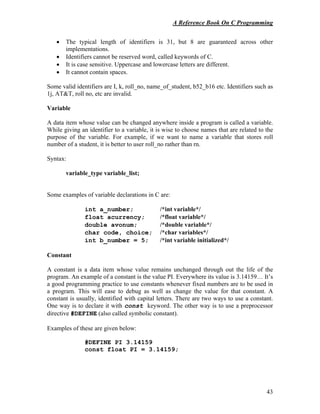

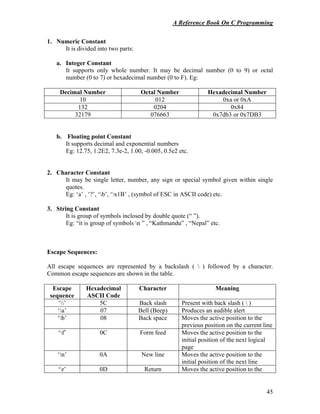

![A Reference Book On C Programming
47
Some rules to follow while writing a C program
• Required header files must be included.
• There must be function with name main.
• Every statement should terminate with semicolon ( ; ).
• Variables must be declared at the beginning of a block.
• Variables and constants must be declared before they can be used.
Delimiters
A delimiter is a nothing but a symbol that has a syntactic meaning and significance in C
language. They do not specify any operation to yield a value. They are shown in table:
Symbol Character Meaning
# Hash Preprocessor directive
, Comma Variable delimiter in variable list
; Semi Colon Statement delimiter
( ) Parenthesis Used in expression
[ ] Square Bracket Used with array
{ } Curly Braces Used to block C sentences
: Colon
& Ampersand
% Percentage
? Question Mark
Table 3.9 Delimiters](https://image.slidesharecdn.com/areferencebookoncprogramming-230102041719-96de32f3/85/A-Reference-Book-on-C-Programming-pdf-50-320.jpg)

![A Reference Book On C Programming
49
Example:
#include<stdio.h>
void main()
{
char s[40];
printf(“Type a string (Less than 40 characters):”);
gets(s);
printf(“The string you typed is :”);
puts(s);
}
Output:
Type a string (Less than 40 characters): C Programming
The string you typed is: C Programming
Example of Formatted Input and Output:
#include<stdio.h>
#include<conio.h>
void main(void)
{
int a=12345;
float b=1224.2365;
char p='a';
char name[30]="Kathmandu Engineering College";
clrscr();
printf("%dnn",a);
printf("%2dnn",a);
printf("%40dnn",a);
printf("%040dnn",a);
printf("%-40dnn",a);
printf("%fn",b);
printf("%9.4fn",b);
printf("%10.2fn",b);
printf("%-10.1fn",b);
printf("%10.2en",b);
printf("%10.2en",-b);
printf("%10cn",p);
printf("%sn",name);
printf("%10sn",name);
printf("%20.10sn",name);
printf("%.5sn",name);
getch();
}](https://image.slidesharecdn.com/areferencebookoncprogramming-230102041719-96de32f3/85/A-Reference-Book-on-C-Programming-pdf-52-320.jpg)






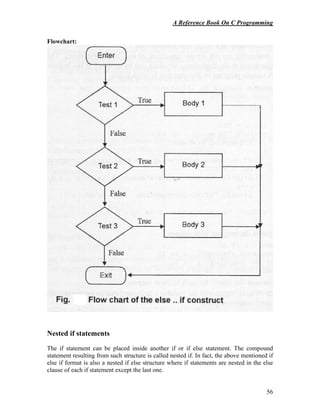


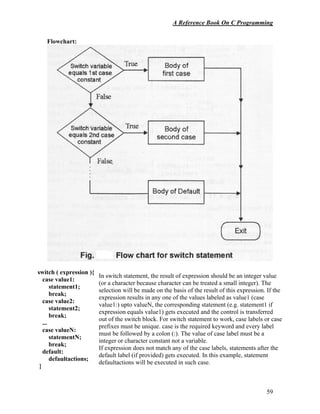

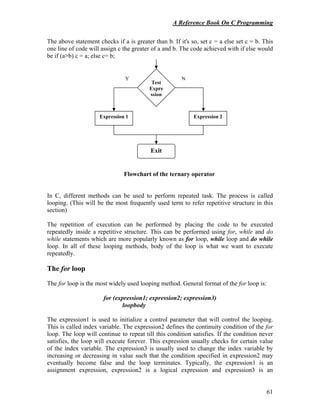
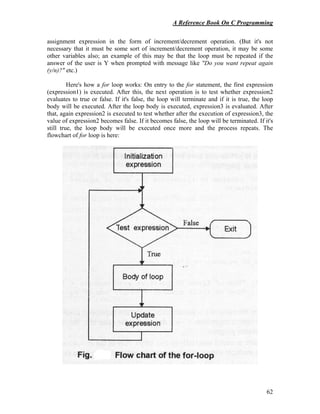


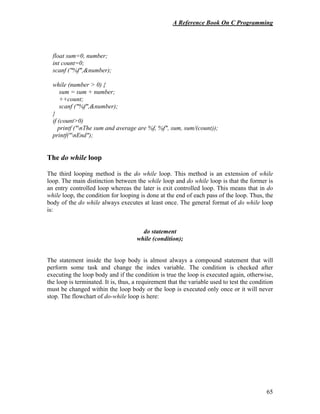


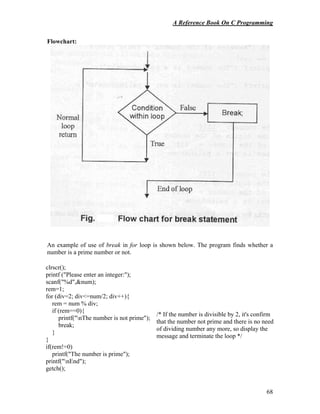


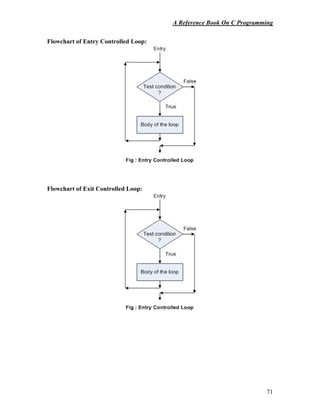


![A Reference Book On C Programming
74
So, to be more precise, the first line of the function body can generally be written as:
return_data_type function_name (type1 arg1, type2 arg2, type3 arg3 ... typeN argN)
The function body
The second part of the function definition is the body of the function. This portion of that
function definition contains the declarations of its local variables and executable
statements. The body of a function defines the operations that function will perform. It
may perform some operations (processing) on the passed arguments, or perform some
entirely new things and return or may not return the result or any other value. The body
can contain compound statements, control statements like if else, looping statements like
for, while or combinations of them and call different functions.
The return statement
The result of the function or any value can be returned from the function by using return
statement. The syntax for return statement is:
return [(expression)];
Here, the expression is optional. For functions that do not return any result to the calling
program (void functions) we cannot provide expression. For other cases, we have to
provide the expression which is evaluated at the end of the function and the result is
returned to the calling function. The return statement can return only one value to the
calling function!.
A function with return type of void cannot return any value, so in this case, there would
be no expression. That means, if the expression is omitted, the control is transferred to the
calling program without returning any value. If the expression is present, the result of the
expression should match the return data type of the function. There can be any number of
return statements inside a function, but only one will be effective depending upon the
condition that which one is evaluated inside the function body when it completes its task.
If the return statement is not present in a function, the control still transfers to the calling
function but without any value or a garbage. When there is no return statement, control is
transferred back to the calling program when the closing brace of the function is reached.
It is called "falling off the end". An example of function without return statement is
shown below.
/* function without a return statement falls of the end */
void showMessage () {
printf("nPress any key to continue");
}](https://image.slidesharecdn.com/areferencebookoncprogramming-230102041719-96de32f3/85/A-Reference-Book-on-C-Programming-pdf-77-320.jpg)




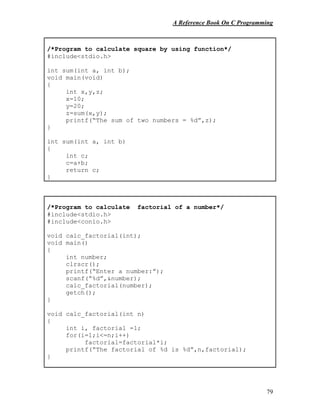



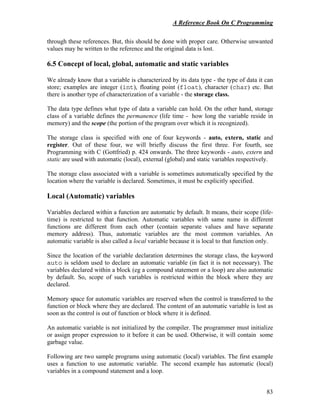
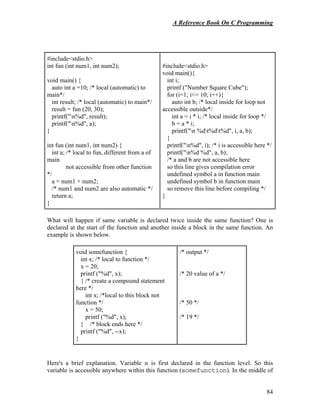

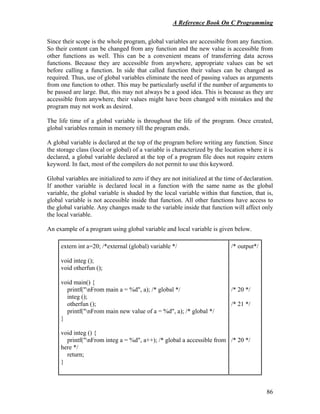



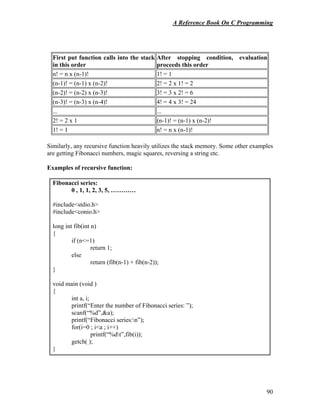
![A Reference Book On C Programming
91
// Program to find length of the string using recursive function
#include<stdio.h>
#include<conio.h>
int length(char str[]);
void main(void)
{
char *string; //char string[10];
clrscr();
printf("Enter String:");
scanf("%s",string); // gets(string);
printf("The length of the string is %d",length(string));
getch();
}
I
int length(char str[])
{
static int i;
if(*(str+i)=='0') //if(str[i]=='0')
return i;
else
{
i=i+1;
length(str);
}
}](https://image.slidesharecdn.com/areferencebookoncprogramming-230102041719-96de32f3/85/A-Reference-Book-on-C-Programming-pdf-94-320.jpg)

![A Reference Book On C Programming
93
//Program to calculate xy
using recursive function
#include<stdio.h>
#include<conio.h>
int calpower(int,int);
void main()
{
int x,y;
clrscr();
printf("Enter the value of x and y:");
scanf("%d%d",&x,&y);
printf("The reqd value is %d",calpower(x,y));
getch();
}
int calpower(int a, int b)
{
if(b==0)
return 1;
else
return a*calpower(a,b-1);
}
//Program to reverse the given word using recursive function
#include<stdio.h>
#include<conio.h>
#include<string.h>
void reverse(char str[],int);
void main(void)
{
char *string; //char string[100];
clrscr();
printf("Enter String:");
scanf("%s",string); // gets(string);
reverse(string,strlen(string));
getch();
}
void reverse(char str[],int len)
{
putchar(str[len]);
if(len>=1)
reverse(str,len-1);
}](https://image.slidesharecdn.com/areferencebookoncprogramming-230102041719-96de32f3/85/A-Reference-Book-on-C-Programming-pdf-96-320.jpg)
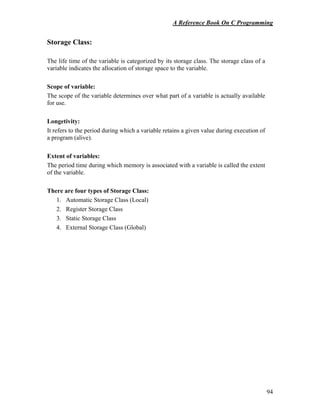




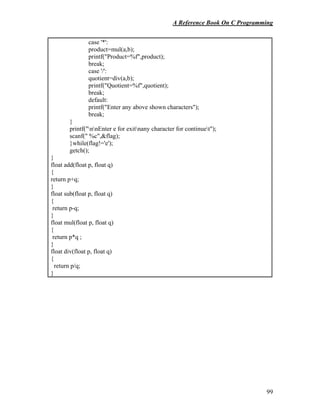
![A Reference Book On C Programming
99
Chapter 7.0
7.0. Array, Pointers and Strings
Arrays:
• An array is defined as a set or collection of data items of the same type.
• The data item grouped in an array can be simple types like integer, float or
character
• It is also called subscripted variable
Types of Arrays:
• One dimensional array
• Two dimensional array
• Multi dimensional array
A. One dimensional array
• Elements of the array could be represented a single row.
• While dealing with one dimensional arrays, we specify a single
subscript to locate a specific element
Declaring one dimensional array:
Syntax: data_type array_name[size];
e.g: float marks[10];
Global declaration:
int number[50]; //global declaration
main( )
{
………
}
Local decleration:
main( )
{
int number[20]; //local declaration
}
Initialization of one dimensional array
Syntax:
data_type array_name[size]={list of arguments};
Global initialization:
int num[ ]= {10,20,35,40,45};//global initialization
main( )
{
………….
}](https://image.slidesharecdn.com/areferencebookoncprogramming-230102041719-96de32f3/85/A-Reference-Book-on-C-Programming-pdf-103-320.jpg)
![A Reference Book On C Programming
100
Local initialization:
main( )
{
int num[ ]= {10,20,35,40,45};//local initialization
}
Rules for array initialization:
• If the number of initializes is less than the number of elements in the array
the remaining elements are set to zero
• It is an error to specify more initializes than the no. of elements in the array
• It is not necessary to specify the size of an array especially in the case , if
initializes are provided for the array
Accessing one dimensional array element:
• To access individual elements of array a subscript or index must be used.
• The subscript identifies the sub element or component of the array that is to
be accessed.
• The subscripts must start at 0 and proceed in increments of 1.
• An array should only support subscript ranging from 0 to n-1
One Dimensional Array element in memory:
int num[8]; //array declaration
What happens in the memory?
• 16 bytes get immediately reserved in memory, 2 bytes for each for the 8
integers
int num[8]= {2,4,3,12,5,45,5,6};
num[0]=2 , num[1]=4 , num[2]=3 ……. num[7]=6
2 4 3 12 5 45 5 6
num
Elements num[0] num[1] num[2] num[3] num[4] num[5] num[6] num[7]
4002 4004 4006 4008 4010 4012 4014 4016
Address](https://image.slidesharecdn.com/areferencebookoncprogramming-230102041719-96de32f3/85/A-Reference-Book-on-C-Programming-pdf-104-320.jpg)
![A Reference Book On C Programming
101
Examples on one dimensional array:
1. An example to illustrate how to input/output (access) array element.
#include<stdio.h>
#include<conio.h>
void main (void)
{
float marks[5]; //array declaration
int age[ ] ={23,19,20,21}; //array initialization
int i;
clrscr();
for(i=0;i<5;i++)
{
printf(“Enter element %d :”,i);
scanf(“%f”,&marks[i]); //array input
}
for(i=0;i<5;i++)
{
printf(“%f”,marks[i]); //array output
}
printf(“The initialized array isn”);
for(i=0;i<4;i++)
{
printf(“%d”,age[i]); //initialized array output
}
getch( );
}
Output:
Enter element 0: 80
Enter element 1: 90
Enter element 2: 70
Enter element 3: 80
Enter element 4: 75
80.000000 90.000000 70.000000 80.000000 75.000000
The initialized array is:
23 19 20 21](https://image.slidesharecdn.com/areferencebookoncprogramming-230102041719-96de32f3/85/A-Reference-Book-on-C-Programming-pdf-105-320.jpg)
![A Reference Book On C Programming
102
2. A program to find the average of array elements
#include<stdio.h>
#include<conio.h>
void main( )
{
float marks[5],sum=0,avg;
int i;
clrscr( );
for(i=0;i<5;i++)
{
printf(“Enter element %d:”,i);
scanf(“%f”,&marks[i]);
sum=sum+marks[i];
}
avg=sum/i; // because latest value of i is 5
printf(“Average=%f”,avg);
getch( );
}
Output:
Enter element 0: 1
Enter element 1: 2
Enter element 2: 3
Enter element 3: 4
Enter element 4: 5
Average = 3.0000000
3. A program to find the largest element of the array
#include<stdio.h>
#include<conio.h>
void main( )
{
float marks[5], max;
int i;
clrscr( );
for(i=0;i<5;i++)
{
printf(“Enter element %d: ”,i);
scanf(“%f”,&marks[i]);
}
max=marks[0];
for(i=1;i<5;i++)
{
if(marks[i]>max)
{
max=marks[i];](https://image.slidesharecdn.com/areferencebookoncprogramming-230102041719-96de32f3/85/A-Reference-Book-on-C-Programming-pdf-106-320.jpg)
![A Reference Book On C Programming
103
}
}
printf(“n The highest element is %f”,max);
}
B. Two dimensional Array:
• So far we have discussed the array variables that can store a list of values
• There could be situations where table of values will have to be stored
• It can also be pronounced as a matrix
Syntax:
data_type array_name[row_size][column_size];
Declaration of two dimensional array:
float student[10][10]; //global declaration
void main( )
{
float marks[20][20]; // local declaration
}
Initialization of two dimensional array:
Global initialization:
int marks[3][4] = {{2,3,5,4},{2,5,3,4},{4,3,3,2}};
int marks[][4] = {{2,3,5,4},{1,2,3,4},{4,3,3,2}};
int values[3][4]={1,2,3,4,5,6,7,8,9,10,11,12} ;
main ( )
{
…………
}
Local initialization:
main( )
{
int marks[3][4]={
{2,3,5,4},
{2,5,3,4},
{4,3,3,2}
};
int values[3][4]={1,2,3,4,5,6,7,8,9,10,11,12} ;
}
Accessing two dimensional array elements:](https://image.slidesharecdn.com/areferencebookoncprogramming-230102041719-96de32f3/85/A-Reference-Book-on-C-Programming-pdf-107-320.jpg)
![A Reference Book On C Programming
104
We need the concept of rows and column as in matrix. So we use two loops to
access the elements- one for row and one for column
int values[3][4]={1,2,3,4,5,6,7,8,9,10,11,12} ;
Col 0 Col 1 Col 2 Col 3
Row 0
Row 1
Row 2
Array element in memory:
int s[4][2]={
{1234, 56},
{1235, 33},
{1236, 80},
{1237, 78}
};
Col 0 Col 1
Row 0
Row 1
Row 2
Row 3
Above diagram is only conceptually true
Two Dimensional Array elements in memory:
In Memory whether it is one dimensional or two dimensional array elements are
stored in one continuous chain
1 2 3 4
5 6 7 8
9 10 11 12
1234 56
1235 33
1236 80
1237 78
1234 56 1235 33 1236 80 1237 78
s
s[0][0] s[0][1] s[1][0] s[1][1] s[2][0] s[2][1] s[3][0] s[3][1]
5002 5004 5006 5008 5010 5012 5014 5016
Address
Elements](https://image.slidesharecdn.com/areferencebookoncprogramming-230102041719-96de32f3/85/A-Reference-Book-on-C-Programming-pdf-108-320.jpg)
![A Reference Book On C Programming
105
Examples:
1. Program to illustrate the input and output the elements of a two dimensional array.
void main( )
{
int i,j,num[3][3];
clrscr( );
for(i=0;i<3;i++)
{
for(j=0;j<3;j++)
{
printf(“Enter num[%d][%d]:”i,j);
scanf(“%d”,&num[i][j]);
}
}
for(i=0;i<3;i++)
{
for(j=0;j<3;j++)
{
printf(“%d”,num[i][j]);
}
printf(“n”);
}
getch ( );
}
Output:
Enter num[0][0]: 1
Enter num[0][1]: 2
Enter num[0][2]: 3
Enter num[1][0]: 4
Enter num[1][1]: 5
Enter num[1][2]: 6
Enter num[2][0]: 7
Enter num[2][1]: 8
Enter num[2][2]: 9
Passing One dimensional Arrays to Function:
Like the values of simple variables, it is possible to pass the values of an
array to a function
To pass a one dimensional array to a called function, it is sufficient to list the
name of the array, without any subscripts, and the size of the array as arguments,
The function call,
max(a,n);
will pass the whole array ‘a’ and its size ‘n’ to the called function](https://image.slidesharecdn.com/areferencebookoncprogramming-230102041719-96de32f3/85/A-Reference-Book-on-C-Programming-pdf-109-320.jpg)
![A Reference Book On C Programming
106
The function prototype may be
float max(float a[ ],int n);
In C, the name of the array represents the address of its first element
By passing the array name, we are passing the address of the array to the
called function
The array in the called function refers to the same array stored in the
memory. Hence any changes in the array in the called function will be reflected in
the original array
In C, arrays are automatically passed by reference to a function
The name of an array is the beginning address of where the array data is
stored in memory also known as “pointer constant”
Eg: marks[0] – array element
marks=&mark[0] -- here the array marks holds the address of element
mark[0]
Program to illustrate passing one dimensional array to the function (sorting of array in
ascending order – selection sort)
#include<stdio.h>
#include<conio.h>
void selectionsort(int[],int);
void main( )
{
int marks[5],temp,i,j;
for(i=0;i<5;i++)
{
printf(“Enter element %d:”,i);
scanf(“%d”,&marks[i]);
}
selectionsort(marks,5);
getch( );
}
void selectionsort(int marks[ ], int n)
{
int i,j,temp;
for(i=0;i<n-1;i++)
{
for(j=j+1;j<n;j++)
{
if(marks[i]>marks[j])
{
temp=marks[i];
marks[i]=marks[j];
marks[j]=temp;](https://image.slidesharecdn.com/areferencebookoncprogramming-230102041719-96de32f3/85/A-Reference-Book-on-C-Programming-pdf-110-320.jpg)
![A Reference Book On C Programming
107
}
}
}
printf(“Sorted array is :”);
for(i=0;i<5;i++)
{
printf(“%d”,marks[i]);
}
}
Output:
Enter element 0:90
Enter element 1:78
Enter element 2:7
Enter element 3:56
Enter element 4:45
Sorted array is: 7 45 56 78 90
Passing two dimensional Arrays to Function:
Just as with a one dimensional array, when a two (or higher) dimensional
array is passed as a parameter, the base address of the actual array is sent to the
function (pass by reference)
Some rules:
1. the function must be called by passing only the array name
2. the size of the second dimension must be specified
3. The prototype declaration should be similar to the function
header/decelerator
Some of the valid function declarations are:
void fxn1(int x[8][5],int y[ ]);
void fxn1(int x[ ][5], float m);
int fxn3(int[ ][5], int);
Example:
Program to demonstrate addition of two 2-dimensional array using function
#include<stdio.h>
#include<conio.h>
voidreadarray(int a[][10],int row, int col);
void sum(int a[][10],b[][10],int s[][10],int r1, int c1, int r2, int c2);
void main( )
{
int r1, c1,r2, c2;
int a[10][10], b[10][10], s[10][10];
clrscr( );](https://image.slidesharecdn.com/areferencebookoncprogramming-230102041719-96de32f3/85/A-Reference-Book-on-C-Programming-pdf-111-320.jpg)
![A Reference Book On C Programming
108
printf(“Enter row and col for matrix a:n”);
scanf(“%d%d”,&r1,&c1);
printf(“Enter row and col for matrix b:n”);
scanf(“%d%d”,&r2,&c2);
printf(“Enter elements for array a:n”);
readarray(a,r1,c1);
printf(“Enter elements for array b:n”);
readarray(b,r2,c2);
sum(a,b,s,r1,c1,r2,c2);
getch( );
}
void readarray(int a[][10], int row, int col)
{
int i,j;
for(i=0;i<row;i++)
{
for(j=0;j<col;j++)
{
printf(“Enter elements [%d][%d]”,i,j) ;
scanf(“%d”,&a[i][j]);
}
}
}
void sum(int a[][10], int b[][10], int s[][10], int r1, int c1, int r2, int c2)
{
if( r1==r2 && c1==c2)
{
printf(“The sum matris is:n”);
for(i=0;i<r1;i++)
{
for(j=0;j<c1;j++)
{
s[i][j]=a[i][j]+b[i][j];
printf(“%dt”, s[i][j]);
}
printf(“n”);
}
}
}](https://image.slidesharecdn.com/areferencebookoncprogramming-230102041719-96de32f3/85/A-Reference-Book-on-C-Programming-pdf-112-320.jpg)
![A Reference Book On C Programming
109
This program reads two 2-dimensional arrays, passes them to a function to multiply
multiplies them and displays the result on the screen from the main function.
#include<stdio.h>
#include<conio.h>
void mul2darray(int[][10],int[][10],int [][10],int,int,int);
void main()
{ int b,i,j,num1[10][10],r1,c1,k, num2[10][10],r2,c2,num3[10][10];
clrscr();
printf("Enter the maximum size of row and column of array num1:");
scanf("%d%d",&r1,&c1);
printf("Enter the maximum size of row and column of array num2:");
scanf("%d%d",&r2,&c2);
if(c1==r2)
{
for(i=0;i<r1;i++)
{
for(j=0;j<c1;j++)
{
printf("Enter num1[%d][%d]:",i,j);
scanf("%d",&num1[i][j]);
}
}
for(i=0;i<r2;i++)
{
for(j=0;j<c2;j++)
{
printf("Enter num2[%d][%d]:",i,j);
scanf("%d",&num2[i][j]);
}
}
mul2darray(num1,num2,num3,r1,c1,c2);
for(i=0;i<r1;i++)
{
for(j=0;j<c2;j++)
{
printf("%d ",num3[i][j]);
}
printf("n");
}
}
else
{
printf("Array size mismatch.");
}
getch();](https://image.slidesharecdn.com/areferencebookoncprogramming-230102041719-96de32f3/85/A-Reference-Book-on-C-Programming-pdf-113-320.jpg)
![A Reference Book On C Programming
110
}
void mul2darray(int num1[][10],int num2[][10],int num3[][10],int r1,int c1,int c2)
{
int i,j,k;
for(i=0;i<r1;i++)
{
for(j=0;j<c2;j++)
{ //*(*(num3+i)+j)=0;
num3[i][j]=0;
for(k=0;k<c1;k++)
{
num3[i][j]=num3[i][j]+num1[i][k]*num2[k][j];
//*(*(num3+i)+j)=*(*(num3+i)+j)+(*(*(num1+i)+k))*(*(*(num2+k)+j));
}
//printf("t%d",num3[i][j]);
}
printf("n");
}
}output
Enter the maximum size of row and column of array num1:3 3
Enter the maximum size of row and column of array num2:3 3
Enter num1[0][0]:0
Enter num1[0][1]:2
Enter num1[0][2]:3
Enter num1[1][0]:5
Enter num1[1][1]:0
Enter num1[1][2]:7
Enter num1[2][0]:1
Enter num1[2][1]:0
Enter num1[2][2]:1
Enter num2[0][0]:2
Enter num2[0][1]:0
Enter num2[0][2]:5
Enter num2[1][0]:3
Enter num2[1][1]:0
Enter num2[1][2]:0
Enter num2[2][0]:5
Enter num2[2][1]:3
Enter num2[2][2]:1
21 9 3
45 21 32
7 3 6](https://image.slidesharecdn.com/areferencebookoncprogramming-230102041719-96de32f3/85/A-Reference-Book-on-C-Programming-pdf-114-320.jpg)
![A Reference Book On C Programming
111
C. Multidimensional arrays
• C allows arrays of three or more dimensions.
• The exact limit is determined by the compiler
The general form is
data_type array_name[s1][s2][s3][s4]…….s[m]
int num[3][10][4][5];
where num is a four dimensional array declared to contain 600
integer type elements.](https://image.slidesharecdn.com/areferencebookoncprogramming-230102041719-96de32f3/85/A-Reference-Book-on-C-Programming-pdf-115-320.jpg)





![A Reference Book On C Programming
117
4. An interger can be added and subtracted from a pointer
variable(pv+1,pv+3,pv-3,pv++)
Eg :
int i=4,*j;
j=&i;
j=j+1;
5. One pointer variable can be subtracted from another provided both pointers
point to elements of the same array
Eg:
int a[ ]= {10,20,30,45,67,56,74}; //4002
int *i,*j;
i=&a[1]; //4004
j=&a[5]; //4012
printf(“%d %d”,j-i, *j-*i); //4 36
6. Two pointer variables can be compared provided both pointers point to
elements of the same data type
Note:
1. Pointer variable cannot be multiplied or divided
2. Two pointers variable cannot be added
Pointer increments and scale factor:
If p is a pointer variable, we can use pointer arithmetic as
p=p+2;
p=p+1;
• Here the pointer p=p+1 will cause the pointer p to point to the next value of
its type.
p => integer pointer
• If p is pointing to the address 1000, then after operation p=p+1; the value of
p will be 1002 not 1001.
• When we increment a pointer, its value is incremented by the length of the
data type that it points to, this length is called the scale factor
Data Type Scale Factor
char 1
int 2
float 4
double 8
long int 4
long double 10
1000 1002 1004 1006 1008](https://image.slidesharecdn.com/areferencebookoncprogramming-230102041719-96de32f3/85/A-Reference-Book-on-C-Programming-pdf-121-320.jpg)

![A Reference Book On C Programming
119
Arrays and pointers:
In case of one dimensional array:
int num[8]= {2,4,3,12,5,45,5,6};
num[0]=2 , num[1]=4 , num[2]=3 ……. num[7]=6
• We know that on mentioning the name of the array we get its base address
num[0]=2
&num[0]=4002 (base address)
*(&num[0])=2
num=4002 (base address)
• By saying *num we would be able to refer to the zeroth element of the array
i.e 2
*num = *(num+0) = 2
Similarly,
*(num+1) => refers to the 1st
element of the array,i.e 4
• In fact Compiler understands,
num[i] is same as *(num+i)
• Following notations are same:
num[i]
*(num+i)
*(i+num)
i[num]
• If you want to calculate the address of
num[4] = base address+(index*scale factor of int)
=4002+(4*2) = 4010
Array indexing Pointer notation
Address of ith
element &num[i] (num+i)
Value of ith
elements num[i] *(num+i)
2 4 3 12 5 45 5 6
num
Elements num[0] num[1] num[2] num[3] num[4] num[5] num[6] num[7]
4002 4004 4006 4008 4010 4012 4014 4016
Address](https://image.slidesharecdn.com/areferencebookoncprogramming-230102041719-96de32f3/85/A-Reference-Book-on-C-Programming-pdf-123-320.jpg)
![A Reference Book On C Programming
120
Let p be the integer pointer (int *p;), then
p = num+0= &num[0] = 4002
p+1 = num+1 &num[1] = 4004
p+2 = num+2 = &num[2] = 4006
p+3 = num+3 = &num[3] = 4008
*p = *num = num[0] = 2
*(p+1) = *(num+1) = 4
In case of Two dimensional array:
int s[4][2]={
{1234, 56},
{1235, 33},
{1236, 80},
{1237, 78}
};
• Each row of a two dimensional array can be thought as a one dimensional
array
• Above example s[4][2] can be thought as setting up an array of 4 elements,
each of which is one dimensional array containing 2 integers
• If s is 1-D array then s[0] gives the zeroth element and s[1] gives the next
element
• More specially, s[0] gives the address of the zeroth 1-D array, s[1] gives the
address of the first 1-D array
Address of 0th
1-D array s[0] = 5002
Address of 1st
1-D array s[1] = 5006
Address of 2nd
1-D array s[2] = 5010
Address of 3rd
1-D array s[3] = 5014
1234 56 1235 33 1236 80 1237 78
s
s[0][0] s[0][1] s[1][0] s[1][1] s[2][0] s[2][1] s[3][0] s[3][1]
5002 5004 5006 5008 5010 5012 5014 5016
Address
Elements](https://image.slidesharecdn.com/areferencebookoncprogramming-230102041719-96de32f3/85/A-Reference-Book-on-C-Programming-pdf-124-320.jpg)
![A Reference Book On C Programming
121
• Each 1-D occupies 4 bytes (two bytes for each integer)
• 1-D array are placed linearly(zeroth 1-D array followed by first 1-D array)
Eg: Suppose we want to refer to the element s[2][1] using pointer
s[2] => 5010 i.e address of 2nd
one - D array
s[2]+1 => (5010+1) => 5012
Value at this address can be obtained by using the “value at address
operator”
*(s[2]+1) = 80 (value)
*(*(s+2)+1) = 80 , since num[i] = *(num+i)
In general,
s[i][j] = *(s[i]+j) = *(*(s+i)+j)
Array indexing Pointer notation
Address of element at
ith
row & jth
col
&num[i][j] (*(num+i)+j
Value of element at ith
row & jth
col
num[i][j] *(*(num+i)+j)
Example:
//pointer notation to access array elements
#include<stdio.h>
#include<conio.h>
void main( )
{
int age[10],i;
clrscr( );
printf(“Enter numbers:”);
for(i=0;i<n;i++)
{
scanf(“%d”,age+i);
}
for(i=0;i<n;i++)
{
printf(“%d”,*(age+i));
}
getch( );
}
Pointers to pointer ( Chain of pointers):
• It is possible to make a pointer to point to another pointer, thus creating a
chain of pointers](https://image.slidesharecdn.com/areferencebookoncprogramming-230102041719-96de32f3/85/A-Reference-Book-on-C-Programming-pdf-125-320.jpg)
![A Reference Book On C Programming
122
• Here, the pointer variable p2 contains the address of the pointer variable p1,
which points to the location that contains the desired value. This is known as
multiple declarations
• A variable that is a pointer to a pointer must be declared using additional
indirection operator symbols in front of the name
• General format :
ƒ data_type **pointer_variable;
ƒ eg: int **p2;
Example:
#include<stdio.h>
void main( )
{
int x, *p1, **p2;
x = 100;
p1 = &x;
p2 = &p1;
printf(“%d”,**p2);
}
Output:
100
Array of Pointers:
• Eg: int *p[10]; => which means that p is an array of 10 pointers which
points to integer data type
Address 2
(2000)
Address 1
(1000)
Value
(‘s’)
p2 p1 Variable - c
1000
2000
3000](https://image.slidesharecdn.com/areferencebookoncprogramming-230102041719-96de32f3/85/A-Reference-Book-on-C-Programming-pdf-126-320.jpg)





![A Reference Book On C Programming
128
Review
Function Task
malloc Allocated requested size of bytes and returns a pointer to the first byte of the
allocated space
calloc Allocates space for an array of elements, initializes them to zero and then
returns a pointer to the memory.
free frees the previously allocated space.
realloc Modifies the size of previously allocated space.
Usage example
The standard method of creating an array of ten integers on the stack:
int array[10];
But if we want to allocate the array dynamically we should write:
#include <stdio.h>
/* Allocate space for an array with 10 elements of type int */
int *ptr = malloc(sizeof(int) * 10);
if (ptr == NULL)
exit(1); /* We could not allocate any memory, so exit */
/* allocation succeeded */
Examples
Example 1: This program asks the required size of array to the user and displays
the addresses of allocated blocks.
#include<stdio.h>
#include<conio.h>
#include<alloc.h>
void main(void)
{
int n,i;
float *address;
clrscr();
printf("Enter number of elements:");
scanf("%d",&n);
address=(float*)calloc(n,sizeof(int));
if(address==NULL)
{ printf("Memory can not allocated.");
exit();
}
for(i=0;i<n;i++)](https://image.slidesharecdn.com/areferencebookoncprogramming-230102041719-96de32f3/85/A-Reference-Book-on-C-Programming-pdf-132-320.jpg)


![A Reference Book On C Programming
131
*(m+j+1)=*(m+j);
*(m+j)=temp;
}
}
}
}
Output
Enter number of elements:5
Enter array elements:123 456 111 111 23
Element at 2574 is 456.000000
Element at 2578 is 123.000000
Element at 2582 is 111.000000
Element at 2586 is 111.000000
Element at 2590 is 23.000000
Example 4: Write a program to read an array of n elements. The program has to
allocate memory dynamically and pass the array to a function, which has to find the
smallest, and the largest numbers and pass to the calling function. Use pass by
reference if necessary.(2062/5/b)
#include<stdio.h>
#include<conio.h>
void findminmax(int *,int *,int *,int);
void main()
{
int largest,smallest,n,*p,i;
clrscr();
printf("Enter array size:");
scanf("%d",&n);
p=(int*)calloc(n,sizeof(int));]
if(p==NULL)
exit();
for(i=0;i<n;i++)
{
printf("Enter array element [%d]:",i+1);
scanf("%d",(p+i));
}
findminmax(p,&largest,&smallest,n);
printf("Largest=%dnSmallest=%d",largest,smallest);
free(p);
getch();
}
void findminmax(int *array,int *l,int *s, int n)
{](https://image.slidesharecdn.com/areferencebookoncprogramming-230102041719-96de32f3/85/A-Reference-Book-on-C-Programming-pdf-135-320.jpg)
![A Reference Book On C Programming
132
int i;
*l=*(array+0);
*s=*(array+0);
for(i=1;i<n;i++)
{
if(*l<*(array+i))
*l=*(array+i);
if(*s>*(array+i))
*s=*(array+i);
}
}
Output
Enter array size:5
Enter array element [1]:12345
Enter array element [2]:23
Enter array element [3]:354
Enter array element [4]:56
Enter array element [5]:87
Largest=12345
Smallest=23
Example 5: An example to allocate a 2d dynamic array.
#include<stdio.h>
#include<conio.h>
void main(void)
{
int rows,cols,i,j;
float **matrix;
printf("Enter maximum rows:");
scanf("%d",&rows);
printf("Enter maximum columns:");
scanf("%d",&cols);
//allocating memory for the matrix.
/*first allocating a single dimensional array of n float pointers.*/
matrix=(float**)calloc(sizeof(float*),rows);
if(matrix==NULL)
{exit()};
/*Now for each row,allocating a single dimensional array of floats.*/
for(i=0;i<rows;i++)
{
matrix[i]=(float*)calloc(sizeof(float),cols);
if(matrix[i]==NULL)
{exit();}
}
for(i=0;i<rows;i++)
{](https://image.slidesharecdn.com/areferencebookoncprogramming-230102041719-96de32f3/85/A-Reference-Book-on-C-Programming-pdf-136-320.jpg)
![A Reference Book On C Programming
133
for(j=0;j<cols;j++)
{ printf("nEnter element[%d][%d]",i,j);
//scanf("%f",&matrix[i][j]);
scanf("%f",(*(matrix+i)+j));
}
}
for(i=0;i<rows;i++)
{
for(j=0;j<cols;j++)
{ printf("%f",*(*(matrix+i)+j));
}
}
free(matrix);
getch();
}
void linkfloat()
{ float x=0,*y;
y=&x;
x=*y;
}
Example 6: A program to pass a two dimensional dynamic array to a function. In
the following examples find the required position and insert the required syntax to
handle the situation of lack of requested amount of memory dynamically.
#include<stdio.h>
#include<conio.h>
void power(float**,int,int);
void main(void)
{ int rows,cols,i,j;
float **matrix;
printf("Enter maximum rows:");
scanf("%d",&rows);
printf("Enter maximum columns:");
scanf("%d",&cols);
//allocating memory for the matrix.
/* first allocating a single dimensional array of n float pointers.*/
matrix=(float**)calloc(sizeof(float*),rows);
/*Now for each row,allocating a single dimensional array of floats.*/
for(i=0;i<rows;i++)
{
matrix[i]=(float*)calloc(cols,sizeof(float));
}
for(i=0;i<rows;i++)
{](https://image.slidesharecdn.com/areferencebookoncprogramming-230102041719-96de32f3/85/A-Reference-Book-on-C-Programming-pdf-137-320.jpg)
![A Reference Book On C Programming
134
for(j=0;j<cols;j++)
{
printf("nEnter element[%d][%d]",i,j);
//scanf("%f",&matrix[i][j]);
scanf("%f",(*(matrix+i)+j));
}
}
power(matrix,rows,cols);
free(matrix);
getch();
}
void power(float **mat,int ros,int cos)
{ int i,j;
for(i=0;i<ros;i++)
{
for(j=0;j<cos;j++)
{
printf("%f",mat[i][j]*2);
//printf("%f",*(*(mat+i)+j)*2);
}
}
}
void linkfloat()
{ float x=0,*y;
y=&x;
x=*y;
}
Output
Enter maximum rows:3
Enter maximum columns:3
Enter element[0][0]1 Enter element[0][1]2
Enter element[0][2]3 Enter element[1][0]4
Enter element[1][1]5 Enter element[1][2]6
Enter element[2][0]7 Enter element[2][1]8
Enter element[2][2]9
2.0000004.0000006.0000008.00000010.00000012.00000014.00000016.00000018.00000
0
Example 7: A program to use functions to read, process, and display the sum of
two dimensional dynamic arrays.
#include<stdio.h>
#include<conio.h>
void display(float**,int,int);
void readmatrix(float**,int,int);
void processmatrix(float**,float**,int,int);
void main(void)](https://image.slidesharecdn.com/areferencebookoncprogramming-230102041719-96de32f3/85/A-Reference-Book-on-C-Programming-pdf-138-320.jpg)
![A Reference Book On C Programming
135
{ int rows1,cols1,i,j,rows2,cols2;
float **matrix1,**matrix2;
clrscr();
printf("Enter maximum rows of matrix1:");
scanf("%d",&rows1);
printf("Enter maximum colunmns of matrix1:");
scanf("%d",&cols1);
printf("Enter maximum rows of matrix2:");
scanf("%d",&rows2);
printf("Enter maximum colunmns of matrix2:");
scanf("%d",&cols2);
//allocating memory for the matrix1, matrix2.
/* first allocating a single dimensional array of n float pointers.*/
matrix1=(float**)calloc(sizeof(float*),rows1);
matrix2=(float**)calloc(sizeof(float*),rows2);
/*Now for each row,allocating a single dimensional array of floats.*/
for(i=0;i<rows1;i++)
{
matrix1[i]=(float*)calloc(cols1,sizeof(float));
}
for(i=0;i<rows2;i++)
{
matrix2[i]=(float*)calloc(cols2,sizeof(float));
}
readmatrix(matrix1,rows1,cols1);
readmatrix(matrix2,rows2,cols2);
display(matrix1,rows1,cols1);
printf("n");
display(matrix2,rows1,cols1);
processmatrix(matrix1,matrix2,rows1,rows2);
printf("n");
display(matrix1,rows1,cols1);
free(matrix1);
free(matrix2);
getch();
}
void display(float **mat, int r1,int c1)
{
int i,j;
for(i=0;i<r1;i++)
{
for(j=0;j<c1;j++)
{ printf("%f ",*(*(mat+i)+j));
}
}
}](https://image.slidesharecdn.com/areferencebookoncprogramming-230102041719-96de32f3/85/A-Reference-Book-on-C-Programming-pdf-139-320.jpg)
![A Reference Book On C Programming
136
void readmatrix(float **mat,int r1,int c1)
{
int i,j;
for(i=0;i<r1;i++)
{
for(j=0;j<c1;j++)
{
printf("Enter element [%d][%d]",i,j);
scanf("%f",(*(mat+i)+j));
}
}
}
void processmatrix(float** mat1,float** mat2,int r1,int c1)
{
int i,j;
for(i=0;i<r1;i++)
{
for(j=0;j<c1;j++)
{
//mat1[i][j]=mat1[i][j]+mat2[i][j];
*(*(mat1+i)+j)=*(*(mat1+i)+j)+*(*(mat2+i)+j);
}
}
}
Output
Enter maximum rows of matrix1:2
Enter maximum colunmns of matrix1:2
Enter maximum rows of matrix2:2
Enter maximum colunmns of matrix2:2
Enter element [0][0] 1 Enter element [0][1] 2
Enter element [1][0] 3 Enter element [1][1] 4
Enter element [0][0] 5 Enter element [0][1] 6
Enter element [1][0] 7 Enter element [1][1] 8
1.000000 2.000000 3.000000 4.000000
5.000000 6.000000 7.000000 8.000000
6.000000 8.000000 10.000000 12.000000](https://image.slidesharecdn.com/areferencebookoncprogramming-230102041719-96de32f3/85/A-Reference-Book-on-C-Programming-pdf-140-320.jpg)
![A Reference Book On C Programming
137
String and String Handling Functions:
1. Introduction
In C, a string is stored as a null-terminated char array. This means that after the last truly
usable char there is a null, which is represented in C by '0'. The subscripts used for the
array start with zero (0). Any group of characters (except double quote sign) defined
double quotation marks is a constant string.
Example- “We are very laborious students."
Characters strings are used to build meaningful and readable programs. The operations
performed on character strings are:
-Reading and writing strings.
-Combining strings together.
-Copying one string toe another.
-Comparing strings for equality.
-Extracting a portion of a string.
2. Declaring string variables
A string variable is any valid C variable name and is always declared as array. The
general form of declaration of a string is
char string_name[size];
Example- The following line declares a char array called str. C provides fourteen
consecutive bytes of memory. Only the first fourteen bytes are usable for character
storage, because one must be used for the string-terminating null.
char str[15];
When a compiler assigns a character string to a character array, it automatically supplies
a null character ('0') at the end of the string. Therefore, the size should be the maximum
numbers of characters in the string plus one. String is stored in memory as ASCII codes
of the characters that make up the string appended with 0(ASCII value of null). The
following is a representation of what would be in RAM, if the string "Hello, world!" is
stored in this array.
The name of the array is treated as a pointer to the array. The subscript serves as the
offset into the array, i.e., the number of bytes from the starting memory location of the
array. Thus, both of the following will save the address of the 0th
character in the pointer
variable ptr.
ptr = str;
ptr = &str[0];
Characters H e L l o , w o r l d ! '0'
ASCII 72 100 107 107 111 44 32 119 111 114 107 100 33 0
Subscripts 0 1 2 3 4 5 6 7 8 9 10 11 12 13](https://image.slidesharecdn.com/areferencebookoncprogramming-230102041719-96de32f3/85/A-Reference-Book-on-C-Programming-pdf-141-320.jpg)
![A Reference Book On C Programming
138
3. Initializing string variables
Character array may be initialized when they are declared. C permits a character array to
be initialized in either of the following two forms.
char name[15]="kathmandu city";
char name[15]={'k','a','t','h','m','a','n','d','u',' ','c','i',t','y','0'};
C also permits to initialize the character array without specifying the numbers of
elements as-
char name[ ]="kathmandu city";
char name[ ]={'k','a','t','h','m','a','n','d','u',' ','c','i',t','y','0'};
4. Character I/O
getchar( ) function reads a character from the standard input device, while putchar( )
writes a character to the standard output device.
Example 1: A program shows a single character input/output.
#include<stdio.h>
void main()
{
char ch;
printf("Enter a character:");
ch=getchar();
printf("The entered character is:");
putchar(ch);
}
5. Reading strings from terminal
a. Reading words
The scanf function can use with % s format specification to read a string of characters.
The syntax is as
char name[15];
scanf("%s",name);
The problem with the scanf function is that it terminates its input on first white space it
finds.
Note that unlike other variable's scanf calls, in case of character arrays, the ampersand(&)
is not required before the variable name. The scanf function automatically terminates the
string that is read with a null character. If we want to n numbers of words then we need
to read them n times.
Example 2: This program reads and displays a single word using scanf function.
#include<stdio.h>
void main()
{
char namestr[10];](https://image.slidesharecdn.com/areferencebookoncprogramming-230102041719-96de32f3/85/A-Reference-Book-on-C-Programming-pdf-142-320.jpg)
![A Reference Book On C Programming
139
clrscr();
printf("Enter name:");
scanf("%s",namestr);
printf("Name: %s",namestr);
getch();
}
b. Reading a line of text
sometimes, we need to read in an entire line of text from the terminal. At that time scanf
function does not work. In such situations, we need to read the string character by
character by using getchar function in loop and assigning to the character array until a
certain condition meet. After terminating the reading, the null character should be
inserted at the end of the string.
Example 3: This example reads a string character by character until enter key is
pressed(new line character(n)) and inserts the null character at the end. In stead of
new line other character can be used. This is a technique to read strings having
white space characters.
#include<stdio.h>
#include<conio.h>
void main()
{ char namestr[100],ch;
int i;
clrscr();
printf("Enter any string:");
i=0;
do
{ ch=getchar();
namestr[i]=ch;
i++;
}while(ch!='n');
i=i-1;
namestr[i]='0';
printf("String: %s",namestr);
getch();
}
6. Writing string to screen
printf function with %s format is used to print the strings to the screen.
The %s can be used to display an array of characters that is terminated by the null
character. Whih is shown in the above example b. We can also specify the precision with
which the array is displayed. For exampe, the specification %12.5s indicates that that the
first five characters are to be printed in the field with of 12columns. If %-12.5s, the string
will be printed left justified.](https://image.slidesharecdn.com/areferencebookoncprogramming-230102041719-96de32f3/85/A-Reference-Book-on-C-Programming-pdf-143-320.jpg)
![A Reference Book On C Programming
140
Example 4: This program shows the concept of formatted output of strings.
#include<stdio.h>
#include<conio.h>
void main()
{
char namestr[100]="Kathmandu Engineering College";
clrscr();
printf("n%s",namestr);
printf("n%15.4s",namestr);
printf("n%-15.4s",namestr);
printf("n%15.0s",namestr);
printf("n%.3s",namestr);
printf("n%5s",namestr);
getch();
}
Output
Kathmandu Engineering College
Kath
Kath
Kat
Kathmandu Engineering College
Example 5: Study and understand the following example
#include<stdio.h>
#include<conio.h>
void main()
{
char namestr[100]="kathmandu";
int i=0,j;
clrscr();
do
{ j=0;
while(j<=i)
{
printf("%c",namestr[j]);
j++;
}
printf("n");
i++;
}while(namestr[i]!='0');
getch();
}](https://image.slidesharecdn.com/areferencebookoncprogramming-230102041719-96de32f3/85/A-Reference-Book-on-C-Programming-pdf-144-320.jpg)
![A Reference Book On C Programming
141
Output
k
ka
kat
kath
kathm
kathma
kathman
kathmand
kathmandu
7. Arithmetic operations on characters
C allows us to manipulate characters the sane way we do with numbers. Whenever a
charcter constant or character variable is used in an expression,it is automatically
converted into an integer value by the system. To write a character in its integer
representation, we can write it as an integer. For example-
x='A';
print("%d" ,x);
will display the number 65 on the screen. It is also possible to perform arithmetic
operations on the character constants and variables. For example,
x='A'+5;
is valid statement and value of x will be 70.
C also allows us also to use the character constants in relational expressions. for example,
the expression ch>='A'&&ch<='Z' would test whether the character contained in the
variable ch is an upper case letter. A character digit can be converted in to its equivalent
integer value using the following relationship:
i=character-'0';
Where i is an integer variable and character contains the character digit. let us suppose
that characte contains the digit '8', Then,
i =ASCII value of '8'-ASCII value of '0'
=56-48
=8
The library functions atoi converts a string of digits into their integer values. The
function takes the following form.
i=atoi(string);
i is an integer variable and string is a character array of containing a string of digits. Both
of the above concept is illustrated in the following example.
Example 6: This example shows to get the equivalent integer value of a character
digit and the equivalent integer value of string of character digits.
#include<stdio.h>
#include<conio.h>
void main()
{ char ch[5];
char character;
int n,x; clrscr();](https://image.slidesharecdn.com/areferencebookoncprogramming-230102041719-96de32f3/85/A-Reference-Book-on-C-Programming-pdf-145-320.jpg)
![A Reference Book On C Programming
142
printf("Enter a character digit:");
character=getche();
n=character-'0';
printf("nThe equivalent value is %d",n);
printf("nEnter a string of digits character:");
scanf("%s",ch);
x=atoi(ch);
printf("nEquivalent number is %d",x);
getch();
}
Output
Enter a character digit:4
The equivalent value is 4
Enter a string of digits character:56
Equivalent number is 56
8. String I/O
a. gets- This function accepts the name of a string as a parameter, and fills the string with
characters that are input from the keyboard, till a new character is encountered( i.e., till
we press the enter key.) At the end the function gets appends an null character and
returns. The new line character is not added to the string.
b. puts- puts displays the string stored in the string variable.
Most of the following examples are done using gtes and puts function for inputting and
outputting strings.
9. String handling functions
We need to manipulate strings in different ways. As for example, concatenating two
strings, copying one string to another, comparing two strings, finding the length of a
string. To do so we have provided different types of library functions. These library
functions are declared in <string.h>. The functions are briefly discussed below.
a . Strlen() - This function finds the length of a string. To do so it counts and returns the
number of characters in the string without including the null character. The general form
is
l=strlen(string);
where l is the integer variable which receives the value of the length of the string.
string is an argument given to find the length. Which can be given as a constant
string.
Example 7: Illustration of strlen().
#include<stdio.h>
#include<conio.h>
#include<string.h>
void main()
{
char text1[100]; int length;
printf("Enter first string1:");
gets(text1);](https://image.slidesharecdn.com/areferencebookoncprogramming-230102041719-96de32f3/85/A-Reference-Book-on-C-Programming-pdf-146-320.jpg)
![A Reference Book On C Programming
143
length=strlen(text1);
printf("Length of given string=%d",length);
getch();
}
The same task is done without using strlen() which is illustrated in the following
example.
Example 8: Finding length of a given string.
#include<stdio.h>
#include<conio.h>
void main(void)
{
char text[100]; int i=0,length=0;
clrscr();
printf("Enter a string:");
gets(text);
while(text[i]!='0')
{
length++;
i++;
}
printf("nLength of given string is %d",length);
printf("nThe latest value of i is also length(%d)",i);
getch();
}
Output
Enter a string:my name
Length of given string is 7
The latest value of i is also length(7)
b. strcat()
This concatenates(joins) two strings together. its general form is:
strcat(string1,string2);
string1 and string2 are character arrays. Which are given as argument to the function.
When strcat is executed ,string2 is appended to string1. It does so by removing the null
character at the end of string1 and placing string2 from there. The string2 remains
unchanged. Which is illustrated in the following example.
Example 9: Illustration of strcat().
#include<stdio.h>
#include<conio.h>
void main()
{
char text1[100];
char text2[50];
clrscr();
printf("Enter first string1:");
gets(text1);
printf("Enter second string2:");](https://image.slidesharecdn.com/areferencebookoncprogramming-230102041719-96de32f3/85/A-Reference-Book-on-C-Programming-pdf-147-320.jpg)
![A Reference Book On C Programming
144
gets(text2);
strcat(text1,text2);
puts(text1);
getch();
}
The same task is done without using the library function which is illustrated in the following
example
Example 10: Concatenating two strings.
#include<stdio.h>
#include<conio.h>
void main(void)
{
char text1[100];
char text2[100];
char text3[200];
int i=0,j;
clrscr();
printf("Enter string1:");
gets(text1);
printf("Enter string2:");
gets(text2);
while(text1[i]!='0')
{
text3[i]=text1[i];
i++;
}
j=0;
while(text2[j]!='0')
{
text3[i+j]=text2[j];
j++;
}
text3[i+j]='0';
puts(text3);
getch();
}
Output
Enter string1:Kathmandu Engineering
Enter string2:College.
Kathmandu EngineeringCollege.
c. strcpy()
This function copies one string to another. It takes the form
strcpy(deststring,sourcestring);](https://image.slidesharecdn.com/areferencebookoncprogramming-230102041719-96de32f3/85/A-Reference-Book-on-C-Programming-pdf-148-320.jpg)
![A Reference Book On C Programming
145
deststring and sourcestring are two strings as argument to the function. Which may be
character array or string constant. When this function is executed, it will assign the
content of string variable sourcrsting to the string variable deststring.
Example 11: Illustration of strcpy().
#include<stdio.h>
#include<conio.h>
#include<string.h>
void main()
{
char text1[100];
char text2[50];
clrscr();
printf("Enter first string1:");
gets(text1);
printf("Enter second string2:");
gets(text2);
strcpy(text1,text2);
puts(text1);
getch();
}
The same task is done without using the strcpy which is illustrated in the following
example
Example 12: Copying one string to another.
#include<stdio.h>
#include<conio.h>
void main()
{
char text1[50];
char text2[50]; int i=0;
clrscr();
printf("Enter first string1:");
gets(text1);
printf("Enter second string2:");
gets(text2);
while(text2[i]!='0')
{
text1[i]=text2[i];
i++;
}
text1[i]='0';
printf("%s",text2);
getch();
}
Output](https://image.slidesharecdn.com/areferencebookoncprogramming-230102041719-96de32f3/85/A-Reference-Book-on-C-Programming-pdf-149-320.jpg)
![A Reference Book On C Programming
146
Enter first string1:Kathmandu Engineering college.
Enter second string2:KEC,Kalimati.
KEC,Kalimati.
d.strcmp()
The strcmp function compares two strings. The general form of the string is
strcmp(string1,string2);
Where string1 and string2 are arguments which may by character arrays or string
constants. When this function is executed it returns 0 if both strings are equal. If the
strings are not equal then, it returns the numeric difference between first nonmatching
characters in the strings.
Example 13: Illustration of strcmp().
#include<stdio.h>
#include<conio.h>
#include<string.h>
void main()
{
char text1[100];
char text2[50];int c;
clrscr();
printf("Enter first string1:");
gets(text1);
printf("Enter second string2:");
gets(text2);
c=strcmp(text1,text2);
if(c==0)
printf("Strings are equal.");
else
printf("Strings are not equal.");
getch();
}
The same task is done without using the strcpy which is illustrated in the following
example
Example 14: Comparing two strings.
#include<stdio.h>
#include<conio.h>
void main()
{
char text1[50];
char text2[50]; int i=0;
//clrscr();
printf("Enter first string1:");
gets(text1);
printf("Enter second string2:");
gets(text2);
while(text1[i]==text2[i] && text1[i]!='0'&&text2[i]!='0')](https://image.slidesharecdn.com/areferencebookoncprogramming-230102041719-96de32f3/85/A-Reference-Book-on-C-Programming-pdf-150-320.jpg)
![A Reference Book On C Programming
147
{
i++;
}
if(text1[i]=='0'&& text2[i]=='0')
printf("Strings are equal.n");
else
printf("Strings are not equal.");
getch();
}
Output
Run 1:
Enter first string1: Kathmadnu
Enter second string2: Engineering
Strings are not equal.
Run 2:
Enter first string1: College
Enter second string2: College
Strings are equal.
10. Arrays of strings(table of strings)
Generally, we use lists of character strings, as for example, name of students in a class,
lists of names of employs in a organization etc. A list of name can be treated as a table
strings and a two dimensional character array can be used to store the entire list. For
example a character array namelist[5][20]; may be used to store a list of 5 names, each
of length not more than 20 characters.
Suppose, if we initialize the above array as:
char namelist[5][20]={"john", "smith", "trudy", "bob", sherry"};
Which is stord in the tabular form as shown in the following figure:
j o h n s h ‘0’
s m i t h ‘0’
t r u d y ‘0’
b o b ‘0’
s h e r r y ‘0’
The following example shows how to input, output, and access elements of arrays of
characters
Example 15: Sorting of strings in ascending order.
#include<stdio.h>
#include<conio.h>
#include<string.h>
void main()
{
char namelist[5][40],temp[40]; int pass,j;
clrscr();](https://image.slidesharecdn.com/areferencebookoncprogramming-230102041719-96de32f3/85/A-Reference-Book-on-C-Programming-pdf-151-320.jpg)
![A Reference Book On C Programming
148
printf("Enter names:");
for(j=0;j<5;j++)
gets(namelist[j]);
for(pass=0;pass<5-1;pass++)
{
for(j=0;j<5-pass-1;j++)
{
if(strcmp(namelist[j],namelist[j+1])>0)
{
strcpy(temp,namelist[j]);
strcpy(namelist[j],namelist[j+1]);
strcpy(namelist[j+1],temp);
}
}
}
printf(Sorted name list is:);
for(j=0;j<5;j++)
puts(namelist[j]);
getch();
}
11. Strings and Pointer
Like in one dimensional arrays, we can use a pointer to access the individual characters in
a string. Which illustrated in the following examples.
Example 16: Reading and writhing string using pointer notation.
#include<stdio.h>
void main()
{ char *text;
printf("Enter a string:");
gets(text);
puts(text);
}
Example16:
#include<stdio.h>
void main()
{
char *text;
printf("Enter a string:");
scanf("%[^+");
printf("%s",text);
}
Output
Enter a string:Kathmandu Engineering College](https://image.slidesharecdn.com/areferencebookoncprogramming-230102041719-96de32f3/85/A-Reference-Book-on-C-Programming-pdf-152-320.jpg)
![A Reference Book On C Programming
149
is located at kalimati.+
Kathmandu Engineering College
is located at kalimati
Where text is a pointer to a character and assigns the address of first character as the
initial value.
All above discussed examples can be done using pointer notation.
One important use of pointers is in handling of a table of strings. Suppose the following
array of strings:
char namelist[3][20];
This says that namelist is a table containing three names, each with a maximum length of
20 characters(including null character). The total storage requirements for the namelist
table are 60 bytes. We know that rarely the individual strings will be of equal lengths.
Therefore, instead of making each row a fixed number of characters, we can make it
pointer to a string of varying length.
example:
char *namelist[3]={"John Smith", "Sherry", "Dave"};
declares namelist to be an array of three pointers to characters, each pointer pointing to a
particular name as shown below:
namelist[0] John Smith
namelist[2] Sherry
namelist[3] Dave
This declaration allocates only 25 bytes, sufficient to hold all characters as shown below.
J o h n S m i t h ‘/0’
S h e r r y '0'
D a v e '0'
Following example shows sorting of arrays of string using pointer. In the previous example of
sorting we copied the string from one string to another string but in the following example we
will swap the pointer. This technique will eliminate:
-complicated storage management.
-high overheads of moving lines.
Sorting Name List using pointer.
#include<stdio.h>
#include<conio.h>
void main()
{
char *namelist[5],*temp;int i,j,pass;
clrscr();
for(i=0;i<5;i++)
{ printf("Enter name %d",i+1);
gets(namelist[i]);
}
for(pass=0;pass<5-1;pass++)
{
for(j=0;j<5-pass-1;j++)](https://image.slidesharecdn.com/areferencebookoncprogramming-230102041719-96de32f3/85/A-Reference-Book-on-C-Programming-pdf-153-320.jpg)
![A Reference Book On C Programming
150
{
if(strcmp(namelist[j],namelist[j+1])>0)
{
temp=namelist[j];
namelist[j]=namelist[j+1];
namelist[j+1]=temp;
}
}
}
printf("Sorted name list is:n");
for(i=0;i<5;i++)
{
puts(namelist[i]);
}
getch();
}
In the above example the number of rows are fixed. But we can make array of strings(2D
array of characters) dynamic using dynamic memory allocation. Which is illustrated in
the following example.
2d dynamic array of characters.
#include<stdio.h>
#include<alloc.h>
void main()
{
char **namelist;int n,i,length;
clrscr();
printf("Enter numbers of items:");
scanf("%d",&n);
fflush(stdin);
namelist=(char**)calloc(n,sizeof(char*));
if(namelist==NULL)
{
exit();
}
else
{
for(i=0;i<n;i++)
{
printf("Enter length of name %d:",i+1);
scanf("%d",&length);
fflush(stdin);
namelist[i]=(char*)calloc(length,sizeof(char));
printf("Enter string %d",i+1);
gets(namelist[i]);
}
}](https://image.slidesharecdn.com/areferencebookoncprogramming-230102041719-96de32f3/85/A-Reference-Book-on-C-Programming-pdf-154-320.jpg)
![A Reference Book On C Programming
151
for(i=0;i<n;i++)
{
puts(namelist[i]);
}
getch();
}
6.b Write a program that takes a string and pass to a function. The function takes
the string and converts all of its lower case characters to upper case characters if the
first character is in lower case and vice versa. Display the string before conversion
and after conversion in the calling function. Your function must convert the original
string not a copy of it.(2062,baishakh)
#include<stdio.h>
#include<conio.h>
void stringconvert(char[]);
void main()
{
char anystring[100];
clrscr();
printf("Enter a string:");
gets(anystring);
printf("String before conversion : ");
puts(anystring);
stringconvert(anystring);
printf("nstring after conversion : ");
puts(anystring);
getch();
}
void stringconvert(char anystr[])
{
int i;
if(anystr[0]>='A'&&anystr[0]<='Z')
{ i=1;
while(anystr[i]!='0')
{
if(anystr[i]>='a'&&anystr[i]<='z')
{
anystr[i]=anystr[i]-32;
i++;
}
else
{
i++;
continue;
}
}](https://image.slidesharecdn.com/areferencebookoncprogramming-230102041719-96de32f3/85/A-Reference-Book-on-C-Programming-pdf-155-320.jpg)
![A Reference Book On C Programming
152
}
else if(anystr[0]>='a'&&anystr[0]<='z')
{ i=1;
while(anystr[i]!='0')
{
if(anystr[i]>='A'&&anystr[i]<='Z')
{
anystr[i]=anystr[i]+32;
i++;
}
else
{
i++;
continue;
}
}
}
else
printf("nString is started wothout a upper case or a lower case.");
}
USING POINTER NOTATION (result will be same)
#include<stdio.h>
#include<conio.h>
void stringconvert(char*);
void main()
{
char *anystring;
clrscr();
printf("Enter a string:");
gets(anystring);
printf("String before conversion : ");
puts(anystring);
stringconvert(anystring);
printf("nstring after conversion : ");
puts(anystring);
getch();
}
void stringconvert(char *anystr)
{
int i;
if(*(anystr+0)>='A' && *(anystr+0)<='Z')
{ i=1;
while(*(anystr+i)!='0')
{](https://image.slidesharecdn.com/areferencebookoncprogramming-230102041719-96de32f3/85/A-Reference-Book-on-C-Programming-pdf-156-320.jpg)
![A Reference Book On C Programming
153
if(*(anystr+i)>='a' && *(anystr+i)<='z')
{
*(anystr+i) = *(anystr+i)-32;
i++;
}
else
{
i++;
continue;
}
}
}
else if(*(anystr+0)>='a' && *(anystr+0)<='z')
{ i=1;
while(*(anystr+i)!='0')
{
if(*(anystr+i)>='A' && *(anystr+i)<='Z')
{
*(anystr+i) = *(anystr+i)+32;
i++;
}
else
{
i++;
continue;
}
}
}
else
printf("nString is started wothout a upper case or a lower case.");
}
Question-Write a program to insert a string in to another string in the location
specified by the user. Read the strings in the main program and pass them to
function along with the inserting position and return the resulting
string.(2062/poush)
#include<stdio.h>
#include<conio.h>
void insertstring(char[],char[],int);
void main()
{
char mainstring[100],stringtobeinserted[20];
int n; clrscr();
printf("Enter mainstring:");
gets(mainstring);](https://image.slidesharecdn.com/areferencebookoncprogramming-230102041719-96de32f3/85/A-Reference-Book-on-C-Programming-pdf-157-320.jpg)
![A Reference Book On C Programming
154
printf("Enter stringtobeinserted:");
gets(stringtobeinserted);
printf("Enter position to insert a string:");
scanf("%d",&n);
insertstring(mainstring,stringtobeinserted,n);
printf("The new string is:");
puts(mainstring);
getch();
}
void insertstring(char mstr[],char str[],int p)
{
int i=p-1,j=0;
char temp[100];
while(mstr[i]!='0')
{
temp[j]=mstr[i];
i++;j++;
}
temp[j]='0';j=0;i=p-1;
while(str[j]!='0')
{
mstr[i]=str[j];
i++;j++;
}
j=0;
while(temp[j]!='0')
{
mstr[i]=temp[j];
i++;j++;
}
mstr[i]='0';
}
Enter mainstring:Kathmandu Engineering.
Enter stringtobeinserted:College
Enter position to insert a string:11
The new string is:Kathmandu College Engineering.
A program to reverse a word.
#include<stdio.h>
void rev(char[],int);
void main()
{
char string[100];
printf("Enter any sting:");](https://image.slidesharecdn.com/areferencebookoncprogramming-230102041719-96de32f3/85/A-Reference-Book-on-C-Programming-pdf-158-320.jpg)
![A Reference Book On C Programming
155
gets(string);
rev(string,strlen(string));
}
void rev(char s[],int l)
{
putchar(s[l]);
if(l>=0)
{
rev(s,l-1);
}
}
Q. Write a program that prompts the user for two strings assemble them in to a
single string and then print the string reversed. Check whether the assembled string
is palindrome or not.
#include<stdio.h>
#include<conio.h>
#include<string.h>
void main(void)
{
char first[30];
char second[40];
char assembled[100];
char reversed[100];
int i=0,j=0,k=0;
clrscr();
printf("Enter first string:");
gets(first);
printf("Enter second string:");
gets(second);
while(first[i]!='0')
{
assembled[i]=first[i];
i++;
}
assembled[i]=' ';i++;
while(second[j]!='0')
{
assembled[i]=second[j];
j++;i++;
}
assembled[i]='0';
puts(assembled);
printf("The reversed string is:");
for(j=i-1;j>=0;j--)
{](https://image.slidesharecdn.com/areferencebookoncprogramming-230102041719-96de32f3/85/A-Reference-Book-on-C-Programming-pdf-159-320.jpg)
![A Reference Book On C Programming
156
reversed[k]=assembled[j];
k++;
}
reversed[k]='0';
printf("n");
puts(reversed);
if(strcmp(assembled,reversed)==0)
printf("The assembled string is palindrome");
else
printf("The assembled string is not palindrome");
getch();
}
Check whether a string entered by user is a palindrome or not and display a proper
message.
[Hint: A palindrome word spells same back and forth e g : madam, noon].
#include<stdio.h>
#include<conio.h>
#include<string.h>
void main(void)
{
clrscr();
char astring[100];
int i,length,j,flag=1;
printf("Enter a string:");
scanf("%[^n]s",astring);
length=strlen(astring);
for(i=0,j=length;i<length/2;i++,j--)
{
if(astring[i]!=astring[j-1])
{
flag=0;
break;
}
}
if(flag==1)
printf("n%s is a palindrome",astring);
else
printf("n%s is not a palindrome",astring);
getch();
}
A program to find the frequency of a character in the entered string.
(pulchowk lab-5,q.no.11)
#include<stdio.h>
#include<conio.h>](https://image.slidesharecdn.com/areferencebookoncprogramming-230102041719-96de32f3/85/A-Reference-Book-on-C-Programming-pdf-160-320.jpg)
![A Reference Book On C Programming
157
#include<string.h>
void main(void)
{
clrscr();
char astring[100],ch;
int i=0,charactercount=0;
printf("%c",ch);
printf("Enter a string:");
gets(astring);
printf("Enter a character to check its frequecy:");
scanf("%c",&ch);
do
{
if(astring[i]==ch)
charactercount++;
i++;
}while(astring[i]!='0');
printf("nThe number of %c is %d",ch,charactercount);
getch();
}
A program to count the frequency of characters in a string entered by a user.
#include<stdio.h>
#include<conio.h>
void main(void)
{
char string[100];
int counts[256]={0},i=0,j;
clrscr();
printf("Enter a string:n");
scanf("%[^n]",string);
// printf("%s",string);
while(string[i]!='0')
{
counts[string[i]]=counts[string[i]]+1;
i++;
}
for(j=0;j<256;j++)
{
printf("t%c=%d",j,counts[j]);
}
getch();
}
Write a program that finds the longest word in a given string.
#include<stdio.h>](https://image.slidesharecdn.com/areferencebookoncprogramming-230102041719-96de32f3/85/A-Reference-Book-on-C-Programming-pdf-161-320.jpg)
![A Reference Book On C Programming
158
#include<conio.h>
#include<string.h>
void main(void)
{
char string[200],tempword[50],word[50];int i=0,length=0,count=0;
clrscr();
printf("Enter a string:");
scanf("%[^n]",string);
while(string[i]!='0')
{ if(string[i]==' ')
{
tempword[count]='0';
if(length<count)
{
length=count;
strcpy(word,tempword);
}
count=0;
}
else
{
tempword[count]=string[i];
count++;
}
i++;
}
printf("The longest word is :%s and its length is %d.",word,length);
getch();
}
OUTPUT
Enter a string:
kathmandu engineering college is located at kalimati .
The longest word is :engineering and its length is 11.
A program to read a character and test whether it is an alphabet or a number or
special character or control character.
#include<stdio.h>
#include<conio.h>
void main(void)
{
char ch;
clrscr();
printf("Enter a charater:");
ch=getche();
printf("%d",ch);](https://image.slidesharecdn.com/areferencebookoncprogramming-230102041719-96de32f3/85/A-Reference-Book-on-C-Programming-pdf-162-320.jpg)
![A Reference Book On C Programming
159
if(ch>=65&&ch<=90||ch>=97&&ch<=122)
printf("The character is alphabet");
else if(ch>=48&&ch<=57)
printf("nThe character is digit");
else if(ch>=0&&ch<=32||ch==127)
printf("nThe character is control character");
else
printf("nSpecial character");
getch();
}
A program to read a string from users and converting the string to lowercase if the
first character is in lower case and vice versa. 059(p)/4/b, (059/©/2/b-similar), 060/
(P)/5/b)
#include<stdio.h>
#include<conio.h>
void main()
{
int i=1;
clrscr();
char name[200];
printf("Enter a sting:");
gets(name);
if(65<=name[0]&&name[0]<=90)
{ while(name[i]!='0')
{
if(97<=name[i]&&name[i]<=122)
{name[i]=name[i]-32;i++;}
else
{ i++;continue;}
}
puts(name);
}
else if(97<=name[0]&&name[0]<=122)
{
while(name[i]!='0')
{
if(65<=name[i]&&name[i]<=90)
{name[i]=name[i]+32;i++;}
else
{i++;continue;}
}
puts(name);
}
else
printf("nStart string from any alphabetic character.");](https://image.slidesharecdn.com/areferencebookoncprogramming-230102041719-96de32f3/85/A-Reference-Book-on-C-Programming-pdf-163-320.jpg)
![A Reference Book On C Programming
160
getch();
}
A program a program to read a line of characters. Now pass this line to a function
that finds the number of vowels, consonants, digits, white spaces (space and tab
character) and other characters in the line .Your function must return these
numbers to the calling function at once(use pointers). In the calling function, display
those numbers. In this problem count[i] are *(count+i) are used interchangeably.
similarly &count[i] and (count+i) are that is the relation between pointer and array.
#include<stdio.h>
#include<conio.h>
#include<ctype.h>
void charactercount(char[],int*);
void main(void)
{
clrscr();
static char string[200];
int counts[5]={0,0,0,0,0};
printf("Enter a string:");
gets(string);
charactercount(string,counts);
printf("nNumber of vowels =%d",counts[0]);
printf("nNumber of consonants =%d",*(counts+1));
printf("nNumber of digits =%d",counts[2]);
printf("nNumber of white space =%d",*(counts+3));
printf("nNumber of other characters=%d",*(counts+4));
getch();
}
void charactercount(char str[],int *count)
{
int i=0;
while(str[i]!='0')
{
if(isalpha(str[i])>0)
{
if(str[i]=='a'||str[i]=='e'||str[i]=='i'||str[i]=='o'||str[i]=='u')
*(count+0)=*(count+0)+1;
else
count[1]++;
}
else if(isdigit(str[i])>0)
(*(count+2))++;
else if(isspace(str[i])>0)
count[3]=count[3]+1;
else
(*(count+4))++;](https://image.slidesharecdn.com/areferencebookoncprogramming-230102041719-96de32f3/85/A-Reference-Book-on-C-Programming-pdf-164-320.jpg)

![A Reference Book On C Programming
162
// Program to find length of the string using recursive
function
#include<stdio.h>
#include<conio.h>
int length(char str[]);
void main(void)
{
char *string; //char string[10];
clrscr();
printf("Enter String:");
scanf("%s",string); // gets(string);
printf("The length of the string is
%d",length(string));
getch();
}
int length(char str[])
{
static int i;
if(*(str+i)=='0')
//if(str[i]=='0')
return i;
else
{
i=i+1;
length(str);
}
}
//Program to find the HCF of two numbers using recursive
function
#include<stdio.h>
#include<conio.h>
int hcf(int,int);
void main(void)
{
int x,y;
clrscr();
printf("Enter two numbers x and y:");
scanf("%d%d",&x,&y);
printf("The HCF of %d , %d is:%d",x,y,hcf(x,y));
getch();
}](https://image.slidesharecdn.com/areferencebookoncprogramming-230102041719-96de32f3/85/A-Reference-Book-on-C-Programming-pdf-166-320.jpg)
![A Reference Book On C Programming
163
int hcf(int a, int b)
{
if(b%a==0)
return a;
else
hcf(b,b%a);
}
//Program to calculate xy
using recursive function
#include<stdio.h>
#include<conio.h>
int calpower(int,int);
void main()
{
int x,y;
clrscr();
printf("Enter the value of x and y:");
scanf("%d%d",&x,&y);
printf("The reqd value is %d",calpower(x,y));
getch();
}
int calpower(int a, int b)
{
if(b==0)
return 1;
else
return a*calpower(a,b-1);
}
//Program to reverse the given word using recursive
function
#include<stdio.h>
#include<conio.h>
#include<string.h>
void reverse(char str[],int);
void main(void)
{
char *string; //char string[100];](https://image.slidesharecdn.com/areferencebookoncprogramming-230102041719-96de32f3/85/A-Reference-Book-on-C-Programming-pdf-167-320.jpg)
![A Reference Book On C Programming
164
clrscr();
printf("Enter String:");
scanf("%s",string); // gets(string);
reverse(string,strlen(string));
getch();
}
void reverse(char str[],int len)
{
putchar(str[len]);
if(len>=1)
reverse(str,len-1);
}
//Program to calculate length and reverse of the string
using user defined function in array notation
#include<stdio.h>
#include<conio.h>
int string_length(char str[]);
void string_rev(char str[]);
void main()
{
char string[100]; //char *string;
clrscr();
printf("Enter string:");
gets(string);
printf("The length of string
is:%dn",string_length(string));
printf("The reverse of the string is:n");
string_rev(string);
getch();
}
int string_length(char str[])
{
int i=0,length=0;
while (str[i]!='0')
{
length=length+1;
i++;
}
return length;
}](https://image.slidesharecdn.com/areferencebookoncprogramming-230102041719-96de32f3/85/A-Reference-Book-on-C-Programming-pdf-168-320.jpg)
![A Reference Book On C Programming
165
void string_rev(char str[])
{
int len;
len=string_length(str);
while(len>=0)
{
putchar(str[len]);
len=len-1;
}
}
//Program to calculate length and reverse of the string
using user defined function in pointer notation
#include<stdio.h>
#include<conio.h>
int string_length(char *str);
void main()
{
//char string[100];
char *string;
clrscr();
printf("Enter string:");
gets(string);
printf("The length of string
is:%d",string_length(string));
getch();
}
int string_length(char *str)
{
int i=0,length=0;
while (*(str+i)!='0')
{
length=length+1;
i++;
}
return length;
}](https://image.slidesharecdn.com/areferencebookoncprogramming-230102041719-96de32f3/85/A-Reference-Book-on-C-Programming-pdf-169-320.jpg)
![A Reference Book On C Programming
166
//Program for string compare, string concatenation, string
copy from one array to another
#include<stdio.h>
#include<conio.h>
void string_comp(char str1[],char str2[]); //(char
*str1,char *str2);
void string_concat(char str1[], char str2[]);
void string_copy(char str1[],char str2[]);
void main()
{
char string1[100]; //char *string;
char string2[100];
clrscr();
printf("Enter string1:");
gets(string1);
printf("Enter string1:");
gets(string2);
string_comp(string1, string2);
string_concat(string1, string2);
string_copy(string1,string2);
getch();
}
void string_comp(char str1[], char str2[])
{
int i=0;
while (str1[i]==str2[i] && str1[i]!='0' &&
str2[i]!='0')
{
i++;
}
if(str1[i]=='0' && str2[i]=='0')
printf("The strings are equaln ");
else
printf("The strings are not equaln");
}
void string_concat(char str1[], char str2[])](https://image.slidesharecdn.com/areferencebookoncprogramming-230102041719-96de32f3/85/A-Reference-Book-on-C-Programming-pdf-170-320.jpg)
![A Reference Book On C Programming
167
{
int i=0,j=0;
char str3[100];
while(str1[i]!='0')
{
str3[i]=str1[i];
i++;
}
while(str2[j]!='0')
{
str3[i+j]=str2[j];
j++;
}
puts(str3);
}
void string_copy(char str1[], char str2[])
{
int i=0;
while(str2[i]!='0')
{
str1[i]=str2[i];
i++;
}
str1[i]='0';
puts(str2);
}
//Program to find the sum of all the 10 array elements
using pointer notation
#include<stdio.h>
#include<conio.h>
void main()
{
int a[10]; //int *a;
int sum=0;
//int *p;p=a;
clrscr();
printf("Enter 10 elements of array:");](https://image.slidesharecdn.com/areferencebookoncprogramming-230102041719-96de32f3/85/A-Reference-Book-on-C-Programming-pdf-171-320.jpg)
![A Reference Book On C Programming
168
for(int i=0;i<10;i++)
{
scanf("%d",a+i); //p+i
sum=sum+(*(a+i)); //*(p+i)
}
printf("Sum = %d",sum);
getch();
}
//Program to find the maximum and minimum number of array
using pointer
#include<stdio.h>
#include<conio.h>
int max(int*); //int max(int []);
int min(int*); //int min(int []);
void main()
{
int a[10]; //int *a;
//int *p;p=a;
clrscr();
printf("Enter 10 elements of array:");
for(int i=0;i<10;i++)
{
scanf("%d",a+i); //p+i
}
printf("The maximun value is:%dn",max(a));
printf("The minimum value is:%d",min(a));
getch();
}
int max(int* x) //int max(int x[])
{
int maxnum;
maxnum=*x;
for(int i=1;i<10;i++)
{
if ((*(x+i))>maxnum)
{
maxnum=(*(x+i));
}
}
return maxnum;
}](https://image.slidesharecdn.com/areferencebookoncprogramming-230102041719-96de32f3/85/A-Reference-Book-on-C-Programming-pdf-172-320.jpg)
![A Reference Book On C Programming
169
int min(int* x) //int min(int x[]);
{
int minnum;
minnum=*x;
for(int i=1;i<10;i++)
{
if ((*(x+i))<minnum)
{
minnum=(*(x+i));
}
}
return minnum;
}
//Program of Dynamic memory allocation of one dimensional
array to calculate the sum of the array elements using
pointer notation
#include<stdio.h>
#include<conio.h>
#include<alloc.h>
void main()
{
int *p, *q, *sum;
int n,i;
clrscr();
printf("Enter the size for array:");
scanf("%d",&n);
p=(int *)calloc(n,sizeof(int));
q=(int *)calloc(n,sizeof(int));
sum=(int *)calloc(n,sizeof(int));
for(i=0;i<n;i++)
{
printf("Enter element for %d of first array:",i);
scanf("%d",p+i);
}
for(i=0;i<n;i++)
{
printf("Enter element for %d of second
array:",i);
scanf("%d",q+i);
}
for(i=0;i<n;i++)
{](https://image.slidesharecdn.com/areferencebookoncprogramming-230102041719-96de32f3/85/A-Reference-Book-on-C-Programming-pdf-173-320.jpg)

![A Reference Book On C Programming
171
matrix1[i]=(int*)calloc(c1,sizeof(int));
}
for(i=0;i<r2;i++)
{
matrix2[i]=(int*)calloc(c2,sizeof(int));
}
if(r1==r2 && c1==c2)
{
printf("Enter the element of first matrix:nn");
readmatrix(matrix1,r1,c1);
printf("Enter the element of the second
matrix:nn");
readmatrix(matrix2,r2,c2);
display(matrix1,r1,c1);
printf("n");
display(matrix2,r2,c2);
addmatrix(matrix1,matrix2,r1,r2);
printf("nn");
display(matrix1,r1,c1);
}
else
printf("The matrix cannot be added");
free(matrix1);
free(matrix2);
getch();
}
void display(int **mat, int r1, int c1)
{
int i,j;
for(i=0;i<r1;i++)
{
for(j=0;j<c1;j++)
{
printf("%d ",*(*(mat+i)+j));
}
printf("n");
}
}
void readmatrix(int **mat,int r1,int c1)
{
int i,j;
for(i=0;i<r1;i++)](https://image.slidesharecdn.com/areferencebookoncprogramming-230102041719-96de32f3/85/A-Reference-Book-on-C-Programming-pdf-175-320.jpg)
![A Reference Book On C Programming
172
{
for(j=0;j<c1;j++)
{
printf("Enter element[%d][%d]:",i,j);
scanf("%d",(*(mat+i)+j));
//scanf("%d",&mat[i][j]);
}
}
}
void addmatrix(int** mat1,int** mat2, int r1,int c1)
{
int i,j;
for(i=0;i<r1;i++)
{
for(j=0;j<c1;j++)
{
//mat1[i][j]=mat1[i][j]+mat2[i][j];
*(*(mat1+i)+j)=*(*(mat1+i)+j)+*(*(mat2+i)+j);
}
}
}](https://image.slidesharecdn.com/areferencebookoncprogramming-230102041719-96de32f3/85/A-Reference-Book-on-C-Programming-pdf-176-320.jpg)
![A Reference Book On C Programming
173
Chapter 8.0
8.0. Structures
8.1. Introduction
A structure is a collection of variables, possibly of different data types grouped together
under a single name for convenient handling. Structures help to organize complicated
data, particularly in large programs, because they permit a group of related variables to be
treated as a single unit instead of as separate data items.
An array is a data structure that can store more than on data items under a single name
but the limitation is that all the data items must be of same type. Data items with different
types cannot be stored in a single array of one type. If we need different types of data to
be stored in a single unit, we use structures. Thus a single structure might contain integer
elements, floating-point elements, character elements and so on. For this reason, array is
often referred to as a homogeneous data structure but structure is a non-homogeneous
data structure.
This chapter is fully dedicated to structures. We will see how structures are defined, how
their individual variables are accessed and processed, how structures are passed to and
returned from functions etc. In addition, we will see how structure can have arrays as its
element and how array of structures can be used.
The individual variables declared inside a structure are called the members of that
structure. A member of a structure can be of any data type including another structure,
array etc. The individual members of structure are accessed using a special operator
called member access operator. The symbol of member access operator is . (dot).
8.2. Declaring and Defining a Structure
Defining a structure
Structure declaration is somewhat more complicated than declaring ordinary variables or
arrays. A structure must be declared in terms of member variables. In general, the
standard composition of a structure may be defined as
struct [tag] {
member 1;
member 2;
member 3;
...
member n;
};](https://image.slidesharecdn.com/areferencebookoncprogramming-230102041719-96de32f3/85/A-Reference-Book-on-C-Programming-pdf-177-320.jpg)
![A Reference Book On C Programming
174
In the above declaration, struct is the required keyword used to define a structure. Tag is
a name that identifies the structure of this type. For simplicity, we can consider tag as the
name of the structure. Member 1, member 2, ... member n enclosed within { } are the
individual member variables of structure of type tag. Notice the semicolon after the
closing }. The member variables can be of any type - integer, float, double, char, array of
any type, another structure, pointers etc. The requirement is that every member must have
different names. Moreover, we cannot initialize the value for member variables within the
structure definition. We cannot assign the storage class of member variables. This is
because, we are just defining the template for the structure and no memory space is
reserved at this step. When we declare a variable of this structure memory space is
reserved.
After the structure is defined, we can declare the structure-type variables in similar way
to other variables. This can be done while defining the structure as well. So, there are
many ways to declare and define structure and structure type variables. Three cases are
listed below.
struct student {
char name[50];
char roll[13];
int marks;
char remarks[100];
};
struct student s1, s2;
struct student {
char name[50];
char roll[13];
int marks;
char remarks[100];
} st1, st2;
struct {
char name[50];
char roll[13];
int marks;
char remarks[100];
} s1, s2, s3;
In the first example, a structure of type student (this is the tag) is defined with four
member variables - name, roll, marks and remarks. The type of member variables are also
defined in the structure. Altogether, the structure has a size of 50 + 13 + 100 + sizeof (int)
bytes. s1 and s2 are defined as the variables of type struct student. This is a typical
variable declaration for a structure type. Once we define the structure out of any function,
we can declare variables of structure type anywhere and use them.
In the second example, same structure as in first example is defined but the variable
declaration is done differently. The variables are declared within the framework of
structure itself. This is another typical structure-type variable declaration. Here st1 and
st2 are variables of type struct student. We can define more variables of type struct
student whenever we require.
In the third example, we have omitted the tag (name of the structure) but still have the
same members as in first and second examples. Also, we have defined s1, s2 and s3 are
variables of type of this structure. But we don't have the name of the structure. So, with
this definition, we cannot declare new variable of this structure type because we don't
have the name of the structure. If we need more variables, we just put them after s3. This
method of defining a structure is rarely used.](https://image.slidesharecdn.com/areferencebookoncprogramming-230102041719-96de32f3/85/A-Reference-Book-on-C-Programming-pdf-178-320.jpg)
![A Reference Book On C Programming
175
First and second method are mostly used. The rule of variable declaration for structure
type also follows the general rule of variable declaration. The standard syntax format is :
storage-class struct tag var1, var2 ..., varN;
Initializing the structure type variables
A Variable of structure type can also be initialized during its declaration. An example is
shown below.
struct account {
int accNo;
char accType;
char accName[50];
float curBalance;
};
struct account cleint1 = { 11001, 'S', "Some Body1", 500000 };
struct account cleint2 = { 11002, 'F', "Some Body2", 100000 };
In the above example, a structure of a bank account is defined having accNo (account
number), accType (account type), accName (account owners name) and curBalance
(current balance). Two variables client1 and client2 are defined and initialized the values.
The values are assigned as shown below.
client1:
accNo = 11001
accType = S
accName = Some Body1
curBalance = 500000
client2:
accNo = 11002
accType = F
accName = Some Body2
curBalance = 100000
Accessing the member of a structure
The individual members of a structure variable are accessed using the member access
operator "." (also called the dot operator). The syntax is
structure-variable.member-name](https://image.slidesharecdn.com/areferencebookoncprogramming-230102041719-96de32f3/85/A-Reference-Book-on-C-Programming-pdf-179-320.jpg)
![A Reference Book On C Programming
176
For the structures defined in previous examples, we can access different member
variables by using the member access operator as shown below.
client1.accNo
access accNo member of
client1
client1.accNo = 5012; /*set accNo of
client1 to 5012*/
client2.accName
access accName member
of client2
gets(client2.accname); /*read name for
client2*/
st1.name access name member of st1
printf("%s",st1.name); /*display name
member of st1*/
The member access operator (.) is a member of highest precedence group and its
associativity is left to right.
A complete program, which uses a structure type variable to store data for a student, read
the data and display it on the screen, is given below.
struct student{ /* structure definition*/
char name[40];
char roll[15];
int marks;
char remarks[50];
};
void main(){
struct student st; /* variable declaration */
printf("Enter Name:");
fflush(stdin);
gets(st.name); /* read data for members */
printf("Enter Roll No:");
fflush(stdin);
gets(st.roll);
printf("Enter Mark:");
scanf(" %d",&st.marks);
printf("Enter Remarks:");
fflush(stdin);
gets(st.remarks);
puts("You entered:");
printf("%sn%sn%dn%s",st.name, st.roll, st.marks, st.remarks);
}
Structure members can be processed in the same manner as ordinary variables of same
data type. These members can be used as a part of an expression, passed to and returned
from functions.](https://image.slidesharecdn.com/areferencebookoncprogramming-230102041719-96de32f3/85/A-Reference-Book-on-C-Programming-pdf-180-320.jpg)
![A Reference Book On C Programming
177
A whole structure data can be assigned to another structure of same type at once. We
don't need to copy member by member. This is handled by the compiler itself. We cannot
compare to structure variables as a whole. We have to compare them member by
member.
Using typedef
Most programmers use typedef keyword to conveniently define and use a new data type
(user-defined type). Therefore, structures are almost always defined along with typedef
keyword so that subsequent variable declarations are easier. An example of the use of
typedef is shown below.
typedef struct { /* use typedef to define new data type */
int year, month, day;
char weekday[10];
} date;
/*the new data type is date which is a structure having year, month,
day and weekday as member variables*/
void main(){
date today; /* declare today as a variable new data type date note
there is no need of struct keyword or structure tag in this case, so this
is easier*/
today.year = 2002;
today.month = 3;
today.day = 9;
strcpy(today.weekday,"Saturday"); /*members assigned and
displayed*/
printf("%d-%d-%d, %s",today.year,today.month, today.day,
today.weekday);
}
Structure Pointer
Pointer to a structure is one of the very frequently used data item in C. Declaration of a
structure pointer is very similar declaration of pointers to primitive data types. The
pointer variable is preceded by the * symbol and the data type is written before it. The
general syntax is
struct tag *strptr;
Here, tag is the structure name, struct the is keyword and strptr is a pointer variable that
can point to a variable of type struct tag.
A individual member variable of a structure pointer can be accessed using the
dereferencing operator (*). The general syntax for accessing the member through the
pointer is
(*strptr).member-name;](https://image.slidesharecdn.com/areferencebookoncprogramming-230102041719-96de32f3/85/A-Reference-Book-on-C-Programming-pdf-181-320.jpg)
![A Reference Book On C Programming
178
In the above expression the parenthesis is necessary because of the precedence rules of C.
Otherwise, the expression would be equivalent to *(strptr.member-name) which means,
the result of expression is the value pointed by member-name member of strptr variable
of type struct tag.
The construct like (*strptr).member-name frequently occurs in C programs when we use
structures and structure pointer. So, a new member access operator is provided for the
structure pointer. This operator is written using the minus sign followed by a greater than
symbol (->). Hence the expression (*strptr).member-name and strptr->member-name are
equivalent but the second one reduces the complexity and avoids confusion to beginners.
This operator is also a member of highest precedence group and its associativity is left to
right.
An example is shown below that uses a structure and structure pointer to perform the
same operation as given in the example above.
struct student{
char name[40];
char roll[15];
int marks;
char remarks[50];
};
void main(){
struct student st, *pst = &st;
/*st is a structure variable and pst is a pointer that points to st*/
printf("Enter Name:");
fflush(stdin);
gets(st.name);
printf("Enter Roll No:");
fflush(stdin);
gets(st.roll);
printf("Enter Mark:");
scanf(" %d",&st.marks);
printf("Enter Remarks:");
fflush(stdin);
gets(st.remarks);
puts("You entered:"); /*we use -> operator to access the members
pointed by pst*/
printf("%sn%sn%dn%s",pst->name, pst->roll, pst->marks, pst-
>remarks);
}](https://image.slidesharecdn.com/areferencebookoncprogramming-230102041719-96de32f3/85/A-Reference-Book-on-C-Programming-pdf-182-320.jpg)
![A Reference Book On C Programming
179
Comparing the two examples, we can conclude that following are equivalent
st.name pst->name
st.marks pst->marks
(*pst).name pst->name
8.3 Array of structure
An array is a data structure that can store a number of similar data items as a single
entity. We have already seen how arrays of primitive data types can be used to handle
number of similar data as single units. In this section we will see how arrays of structures
can be used to handle more than one structure variable at a time.
Definition of a structure array is similar to that of other variables. The variable is
followed by the number of elements enclosed inside square brackets. The variable name
is preceded by the type of the structure. The general format is
struct tag str-variable [no-of-elements];
Here, struct is the keyword, tag is the name of the structure, str-variable is the name of
the array and no-of-elements in the size of the array.
An example of a structure array is given below. In this example, structure having four
member variables are created and an array containing 48 student type elements is defined.
Every element has its own set of four members and they can be accessed and processed
individually.
struct student {
char name[50];
char roll[13];
int marks;
char remarks[100];
};
struct student students[48];
A particular array element can be accessed by its subscript and members of that elements
can be accessed using the member access operator. For example, students[0] is the first
element in the array and students[1].name is the name member of second element of the
array and so on.
A complete example using a structure array is shown below. This program uses an array
of 48 element array, reads data and displays. If we have not used structure we would have](https://image.slidesharecdn.com/areferencebookoncprogramming-230102041719-96de32f3/85/A-Reference-Book-on-C-Programming-pdf-183-320.jpg)
![A Reference Book On C Programming
180
four arrays for name, roll, marks and remarks and track and process every element of all
four arrays.
struct student{
char name[40];
char roll[15];
int marks;
char remarks[50];
};
void main(){
struct student st[48]; /* array of 48 elements of type student */
int i;
for(i=0; i<3;i++){ /* read data for all members of each element*/
printf("Enter Name:");
fflush(stdin);
gets(st[i].name);
printf("Enter Roll No:");
fflush(stdin);
gets(st[i].roll);
printf("Enter Mark:");
scanf(" %d",&st[i].marks);
printf("Enter Remarks:");
fflush(stdin);
gets(st[i].remarks);
}
printf("You entered:");
for(i=0; i<3; i++) /*display all members of each element*/
printf("n%sn%sn%dn%s", st[i].name, st[i].roll, st[i].marks, st[i].remarks);
}
8.4 Structure within structure
We have already mentioned that a member of a structure can be of any data type. So it is
possible to include a structure as a member of another structure. When we use a structure
as a member of another structure, we must define the member structure before it can be
used in other structure.
In such cases, the member of the inner structure can be accessed through the outer
structure. This is shown in the example below.
An example is shown below. This program defines a structure named person and within
this person, bday is another structure as a member variable.](https://image.slidesharecdn.com/areferencebookoncprogramming-230102041719-96de32f3/85/A-Reference-Book-on-C-Programming-pdf-184-320.jpg)
![A Reference Book On C Programming
181
struct date{ /* first structure*/
int year, month, day;
};
struct person{
char name[40];
char address[15];
struct date bday; /* structure as member in another structure */
};
void main(){
struct person per; /* member of bday can be accessed through per.bday.year and so
on */
printf("Enter Name:"); /* read data*/
fflush(stdin);
gets(per.name);
printf("Enter Address:");
fflush(stdin);
gets(per.address);
printf("Enter Year of Birth:");
scanf(" %d", &per.bday.year);
printf("Enter Month of Birth:");
scanf(" %d", &per.bday.month);
printf("Enter Day of Birth:");
scanf(" %d", &per.bday.day);
printf("Hello, %s", per.name); /* display data*/
printf(" your address is %s and you were born on %d-%d-%d", per.address,
per.bday.year, per.bday.month, per.bday.day);
}
8.5 Structure containing arrays
A structure can contain an array as its member. The member is defined as an ordinary
array of any data type. The elements of the member array is accessed in similar manner
as an ordinary array element. We use subscript after the member name. An example is
shown below. This program has a array of integer numbers as a member in struct student.](https://image.slidesharecdn.com/areferencebookoncprogramming-230102041719-96de32f3/85/A-Reference-Book-on-C-Programming-pdf-185-320.jpg)
![A Reference Book On C Programming
182
struct student {
char name[40];
char roll[15];
int marks[7]; /*array as a member to store 7 marks */
};
void main(){
struct student st;
int i, total=0;
printf("nEnter Name:");
gets(st.name);
printf("Enter Roll No:");
fflush(stdin);
gets(st.roll);
puts("Enter marks for 7 subjects");
for(i=0; i<7; i++) /* read marks for seven subjects */
scanf(" %d",&st.marks[i]);
for(i=0; i<7; i++)
total+=st.marks[i]; /* add marks to get total */
puts("You entered following data:");
printf("nName: %s",st.name);
printf("nRoll No: %snMarks: ",st.roll);
for(i=0; i<7; i++) /*display seven marks and total */
printf("%dt", st.marks[i]);
printf("nTotal: %dnAverage %.2f", total, total/7.0);
}
In this example we have seen how the elements of an array member is accessed and
processed in the program and finally displayed the result.
Structures and Functions
There are several ways to pass structure-type data to or from a function. Structure
members can be transferred individually, or entire structure can be transferred. Individual
members can be passed to a function as arguments in the function call, and a single
member can be returned to the calling function via return statement. To do so, each
structure member is treated as an ordinary variable.
A complete structure can be transferred to a function by passing a structure type data as
an argument. Similarly, a complete structure type data can be returned from a function by
specifying the return type of the function of structure type. Structure type data can be
transferred to and from a function using pointer to that structure in similar manner to
passing and returning an ordinary pointer variable. An example of passing and returning
structure type data to and from a function is shown below. In the next program same
functionality is achieved using pointer to structure.](https://image.slidesharecdn.com/areferencebookoncprogramming-230102041719-96de32f3/85/A-Reference-Book-on-C-Programming-pdf-186-320.jpg)
![A Reference Book On C Programming
183
/* first programming using structure*/
struct student{
char name[40];
char roll[15];
int marks;
char remarks[50];
};
void display (struct student);
struct student readstr ();
void main() {
struct student st;
st=readstr(); /* read data using function
that return a structure type data*/
display (st); /* display structure data by
passing structure to a function */
getch();
}
/* function to read and return structure data
*/
struct student readstr(){
struct student st;
printf ("Enter Name:");
fflush (stdin);
gets(st.name);
printf("Enter Roll No:");
fflush(stdin);
gets(st.roll);
printf("Enter Mark:");
scanf(" %d",&st.marks);
printf("Enter Remarks:");
fflush(stdin);
gets(st.remarks);
return st;
}
/* function to take structure data and
display*/
void display (struct student st){
puts ("You entered:");
printf("%sn%sn%dn%s",st.name, st.roll,
st.marks, st.remarks);
}
/* second program using pointer to
structure*/
struct student{
char name[40];
char roll[15];
int marks;
char remarks[50];
};
void display (struct student *);
void readstr (struct student *);
void main(){
struct student stud;
struct student *st= &stud;
readstr (st); /* read structure data by
passing structure pointer to a function*/
display (st); /* display structure data by
passing structure pointer to a function*/
}
/* function to read and return structure data
through pointer to structure*/
void readstr (struct student *stp){
printf ("Enter Name:");
fflush(stdin);
gets(stp->name);
printf("Enter Roll No:");
fflush(stdin);
gets(stp->roll);
printf("Enter Mark:");
scanf(" %d",&stp->marks);
printf("Enter Remarks:");
fflush(stdin);
gets(stp->remarks);
}
/* function to take structure pointer and
display data pointed by that structure
pointer*/
void display(struct student *st){
puts("You entered:");
printf("%sn%sn%dn%s", st->name, st-
>roll, st->marks, st->remarks);
}](https://image.slidesharecdn.com/areferencebookoncprogramming-230102041719-96de32f3/85/A-Reference-Book-on-C-Programming-pdf-187-320.jpg)
![A Reference Book On C Programming
184
Passing Array of Structure to Function
Example:
Create a structure Student containing name as char string, roll as integer and address as
character string. Input and display name, roll and address for N number of students,
where N is any number input by the user. Input everything from main( ) and display the
contents from display( ) function.
Display the contents in following format:
NAME: name
ADDRESS: address
ROLL NO: roll
#include<stdio.h>
#include<conio.h>
struct student{ /* structure definition*/
char name[50];
int roll;
char address[50];
};
void display (struct student [],int);
void main(){
int n;
clrscr();
struct student st[10]; /* variable declaration */
printf("Enter the number of students:");
scanf("%d",&n);
for(int i=0;i<n;i++)
{
printf("Enter Name:");
fflush(stdin);
gets(st[i].name); /* read data for members */
printf("Enter Roll No:");
fflush(stdin);
scanf(" %d",&st[i].roll);
printf("Enter Address:");
fflush(stdin);
gets(st[i].address);
}
puts("You entered:");
display(st,n);
}](https://image.slidesharecdn.com/areferencebookoncprogramming-230102041719-96de32f3/85/A-Reference-Book-on-C-Programming-pdf-188-320.jpg)
![A Reference Book On C Programming
185
void display(struct student s[],int n)
{
for(int i=0;i<n;i++)
printf("NAME:%snADDRESS:%snROLL NO:%dnn",s[i].name, s[i].address,
s[i].roll);
getch();
}](https://image.slidesharecdn.com/areferencebookoncprogramming-230102041719-96de32f3/85/A-Reference-Book-on-C-Programming-pdf-189-320.jpg)

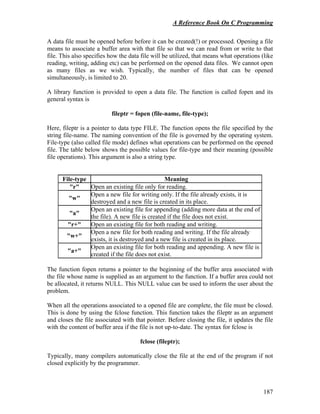

![A Reference Book On C Programming
189
An example is given below that reads some information from the user and writes to a data
file. This program uses three different functions to write to a file. The program will
generate an error message if the file could not be opened.
void main(){
FILE *fileptr; /* required variables */
char name[40];
int roll;
char program[12];
char group;
/* read data to write to a file */
printf ("Enter Name:");
gets (name);
printf ("Enter Roll No:");
scanf (" %d", &roll);
printf ("Enter Program:");
fflush (stdin);
gets (program);
printf ("Enter Group:");
scanf (" %c", &group);
/* create and open the file to write the information*/
fileptr = fopen ("test.txt", "w"); /* open for writing*/
if (fileptr==NULL) { /* file is not opened due to some error so display the
message and quit */
printf ("ERROR opening the file. Press any key to continue...");
getch();
exit(1); /* quit the program*/
}
/* write different types of data to file*/
fprintf (fileptr, "%sn", name); /* write a formatted string at once */
fprintf (fileptr, "%dn",roll); /* write formatted integer data */
fputs(program, fileptr); /* write a string*/
fprintf(fileptr,"n");
fputc(group, fileptr); /* write a single character */
fclose(fileptr); /* close the file explicitly*/
printf("nnData were successfully written to the file");
getch();
}
Reading a data file
An existing data file can be read, its contents processed and written to the file again. We
can read the content of an existing file by opening it in the read mode ( "r" file-type).
Once the file is opened for reading, there are several library functions to read the content.
Some may read only one character, some read a whole line of characters or some read
formatted data. We must read the content of the file in same format as it was written.](https://image.slidesharecdn.com/areferencebookoncprogramming-230102041719-96de32f3/85/A-Reference-Book-on-C-Programming-pdf-193-320.jpg)
![A Reference Book On C Programming
190
Otherwise, we may lose the required information. Table below shows some of the
functions to read data from an existing file.
Function Prototype Purpose
fscanf ()
fscanf (FILE *stream, const char
*format, ...);
read variables from the file
stream (similar to scanf
function but can read from a
data file)
fgetc () fgetc (FILE *stream);
read a single character from
the file stream (similar to
getc but can read from a data
file)
fgets () fgets (char *s, int n, FILE *stream);
read a line from the file
stream (similar to gets but
can read from a data file)
fread ()
fread (void *ptr, size_t size, size_t n,
FILE *stream);
read a block of data at once
such as for a structure
(written format must match
the reading data structure)
Here's an example that reads and displays the content of the previously written
file. The program does this in two ways, character by character until the end of file (a
integer value of -1 to indicate the end of file) is reached and line by line till the end is
reached.
/* display the file character by character */
void main(){
FILE *fileptr;
char ch;
fileptr = fopen ("test.txt","r"); /* open for
reading*/
if (fileptr==NULL) {
printf ("ERROR opening the file. Press
any key to continue...");
getch();
exit(1);
}
/* read character by character untill eond
of file is reached */
while ((ch = fgetc (fileptr))!=EOF) /*
EOF indicated end of file */
putchar (ch);
/* close the file */
fclose (fileptr);
printf("nnEnd of data");
}
/* display the file line by line*/
void main(){
FILE *fileptr;
char line[81];
fileptr = fopen ("test.txt","r"); /* open for
reading*/
if (fileptr==NULL) {
printf ("ERROR opening the file. Press
any key to continue...");
getch();
exit(1);
}
/* read 80 characters at a time until end
of file is reached */
while ((fgets (line, 80,
fileptr))!=NULL)/* when all the lines are
read, line will be NULL */
printf ("%s",line);
/* close the file */
fclose (fileptr);
printf("nnEnd of data");
}](https://image.slidesharecdn.com/areferencebookoncprogramming-230102041719-96de32f3/85/A-Reference-Book-on-C-Programming-pdf-194-320.jpg)
![A Reference Book On C Programming
191
Here is another program that takes two filenames entered by the user and copies the
content of the first file to second file if the first file exists.
void main(){
FILE *srcfile, *trgfile;
char ch;
char sfile[13], tfile[13]; /* file names*/
printf("Enter the source file name:");
scanf(" %s", sfile);
printf("Enter the target file name:");
scanf(" %s", tfile);
srcfile = fopen (sfile, "r"); /* open source for reading*/
if (srcfile==NULL) {
printf ("File %s does not exist. Press any key to continue...", sfile);
getch();
exit(1);
}
trgfile = fopen (tfile, "w"); /* open destination for writing*/
if (trgfile==NULL) {
printf ("File %s cannot be created. Press any key to continue...", tfile);
getch();
exit(1);
}
/* read character by character from srcfile and write to trgfile until end of file in
srcfile is reached */
while ((ch=fgetc (srcfile))!=EOF)
fputc (ch, trgfile);
/* close both files */
fclose (srcfile);
fclose (trgfile);
printf("nn1 file copied.");
}](https://image.slidesharecdn.com/areferencebookoncprogramming-230102041719-96de32f3/85/A-Reference-Book-on-C-Programming-pdf-195-320.jpg)
![A Reference Book On C Programming
192
Here is a program that reads the formatted data from a file using fscanf function. The file
is written using the first example program of this chapter. The formats for reading are
same as format used in writing and all separate data are written in new line.
Function fscanf reads data from each line.
/* read file using fscanf function */
void main(){
FILE *fileptr;
char name[40];
int roll;
char program[12];
char group;
fileptr = fopen("test.txt","r"); /* open file for reading*/
if (fileptr==NULL) {
printf("ERROR opening the file. Press any key to continue...");
getch();
exit(1);
}
/* read one data at a time */
fscanf(fileptr,"%s", name);
fscanf(fileptr,"%d", &roll);
fscanf(fileptr, "%s", program);
fscanf(fileptr, "%s", &group);
/*display the read data */
printf("n%s", name);
printf("n%d", roll);
printf("n%s", program);
printf("n%c", group);
/* close the file */
fclose(fileptr);
printf("nnEnd of data");
}](https://image.slidesharecdn.com/areferencebookoncprogramming-230102041719-96de32f3/85/A-Reference-Book-on-C-Programming-pdf-196-320.jpg)
![A Reference Book On C Programming
193
Record I/O in binary mode
There are functions fread ( ) and fwrite( ) for reading from and writing to structure
(record) in a file on the disk
Example:
#include<stdio.h>
struct employee
{
char name[100];
int salary;
float age;
};
void main()
{
struct employee emp, e;
FILE *filepointer;
char filename[50];
int decision = 1;
printf(“Enter filename:”);
scanf(“%s”,filename);
if((filepointer=fopen(filename, “wb”)= =NULL)
exit();
while(decision)
{
printf(“Enter name salary and age of employees:”);
scanf(“%s%d%f”,emp.name,&emp.salary,&emp.age);
fwrite(&emp,sizeof(emp),1,filepointer);
printf(“Enter n0 to exit: n 1 to continue”);
scanf(“%d”,&decision);
}
fclose(filepointer);
if((filepointer=fopen(filename, “rb”))= =NULL)
exit();
while(fread(&e,sizeof(e),1,filepointer)= =1)
printf(“Name : %snSalary : %dn age : %fn”,e.name,e.salary,e.age);
fclose(filepointer);
getch( );
}
This example reads the structure members from the standard input device, writes them to
the file using function fwrite. It takes four arguments: the first is the address of the
structure to be written to the disk. The second is the size of the structure in bytes, the
third is the number of such structures that we want to write at a time and the fourth is the
pointer to the file where we want to write. Then, the written contents is read back using
function fread, which takes the similar four arguments as in fwrite: address of structure,](https://image.slidesharecdn.com/areferencebookoncprogramming-230102041719-96de32f3/85/A-Reference-Book-on-C-Programming-pdf-197-320.jpg)








